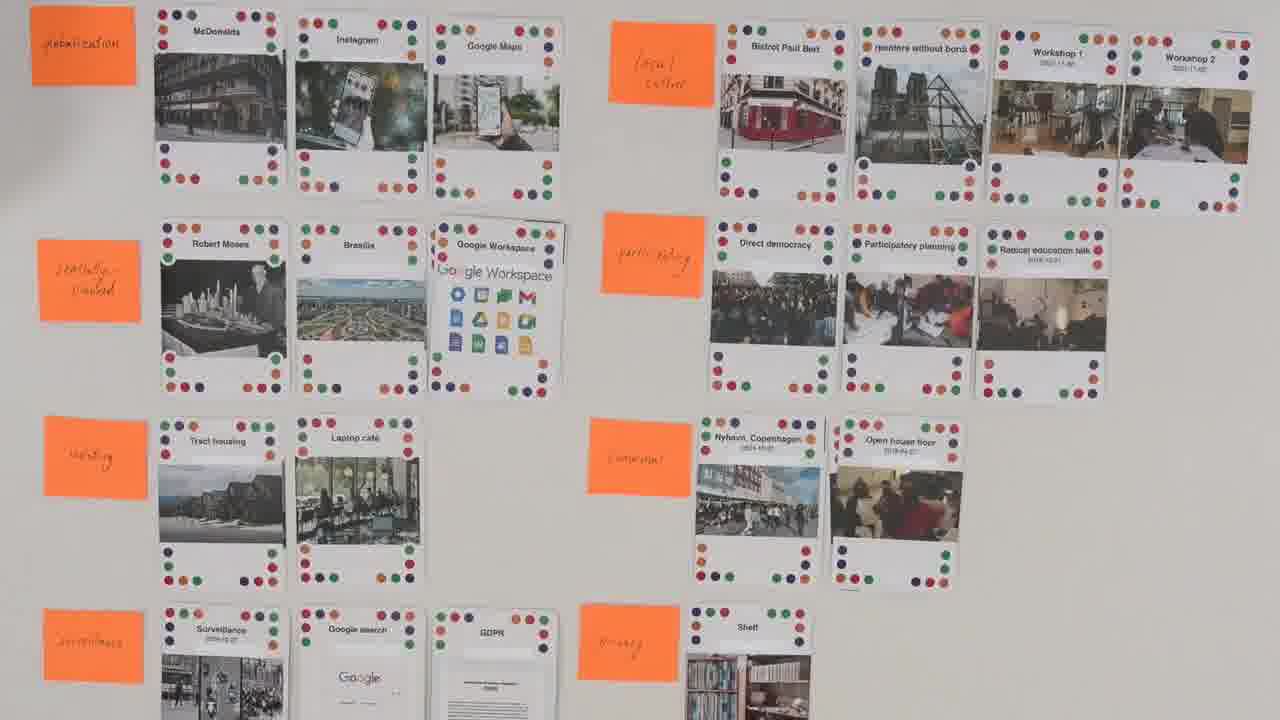Bret Victor — November 2024 —,
Chapters — Intro, Communal computing, This presentation, Physicality — Globalization, Centrally-planned, Isolating, Private property, Surveillance, Consumption, Hidden — Summary, Outline
A values-driven approach to integrating computation into cities.
×
Intro
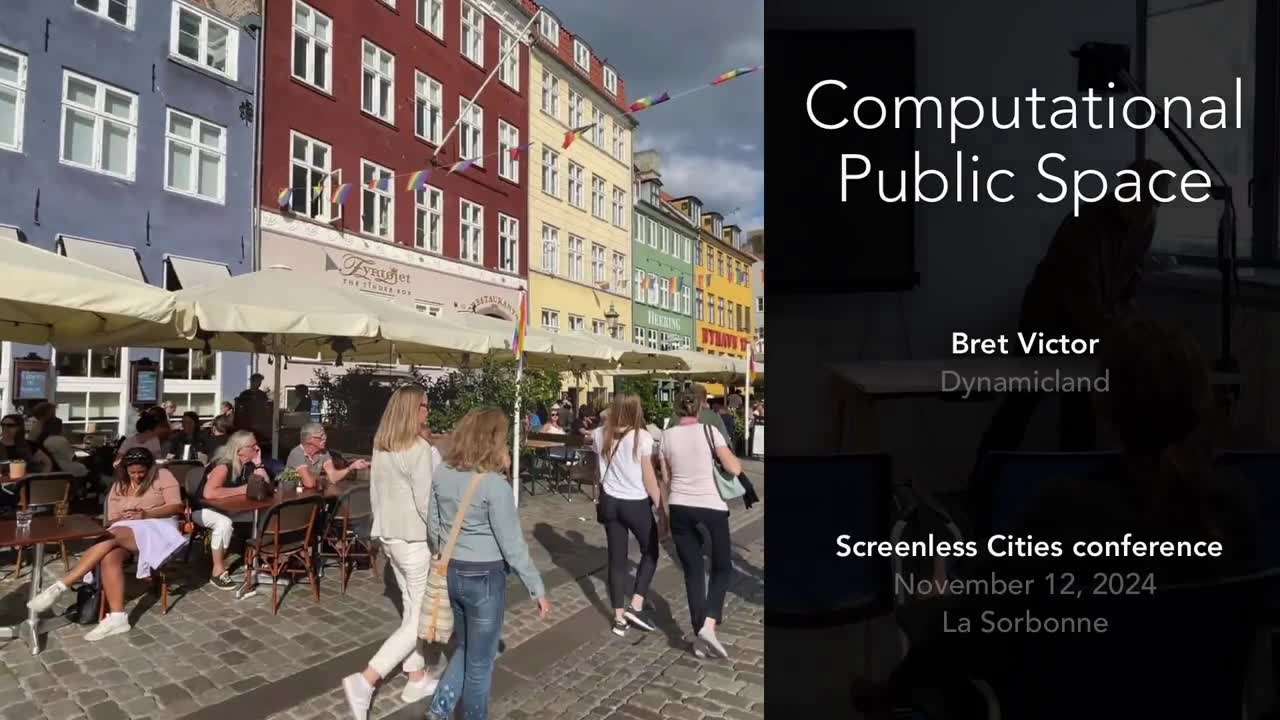
I’m Bret, and I represent Dynamicland, which is a non-profit research space in the United States. We’re creating a new form of computing which doesn’t use screens.
Of course, at the Screenless Cities Conference, we wanted to bring our screenless computer, and give a screenless presentation. So, there’s no laptop up here. I have some cards.
We actually do all of our day-to-day work in the computing system that I’m going to be showing you, including building the computing system itself. It all takes place without screens.
So, the things I’m going to be showing you, not only do they not use screens, they’re not even made with screens. And that includes the entire operating system of the screenless computer. We’re just pretty committed to this idea.

I’m going to talk a bit about this form of computing and what we’re trying to achieve. A big part of what we’re trying to achieve is to enable people to come together in physical space, to work with computation while being present in the same reality.
And you can’t think about integrating computation into space without making a space. So this system was actually created within a community center, a public community space that we started, called Dynamicland, where all kinds of people came through — scientists, artists, teachers, students — all kinds of people using this for their own projects.
So I’m going to talk a bit about the space and some things that people have made in it. But one collaboration that we’ve never had the opportunity to do is to work with cities.
From the very beginning, we’ve been very interested in computation integrated into public space and public life, and we haven’t had a chance to do that work yet. So I’m really excited to be here to get that conversation started with you guys.
So, that’s going to be the second half of the talk, how all this fits in with cities.
To get started talking about what this form of computation is, we probably should start with what it’s not.

This is what computers look like today. These people are together in the same physical space, but they’re each in their own isolated little world.
They’re not aware of what each other is doing. They can’t reach in and help each other. They’re not learning from being around each other.
And this is the same scene, just with smaller screens and smaller people. They’re physically together, but they’re in their own separate worlds.

And the worlds that they’re inhabiting were mass manufactured by an app developer. They’re living in these prefab worlds. They don’t have the agency to create or change the worlds that they live in.
That’s what computers look like today.
And then, the most common visions for the future of computing are that we’re just going to glue the screens to our faces and forget about the real world entirely.
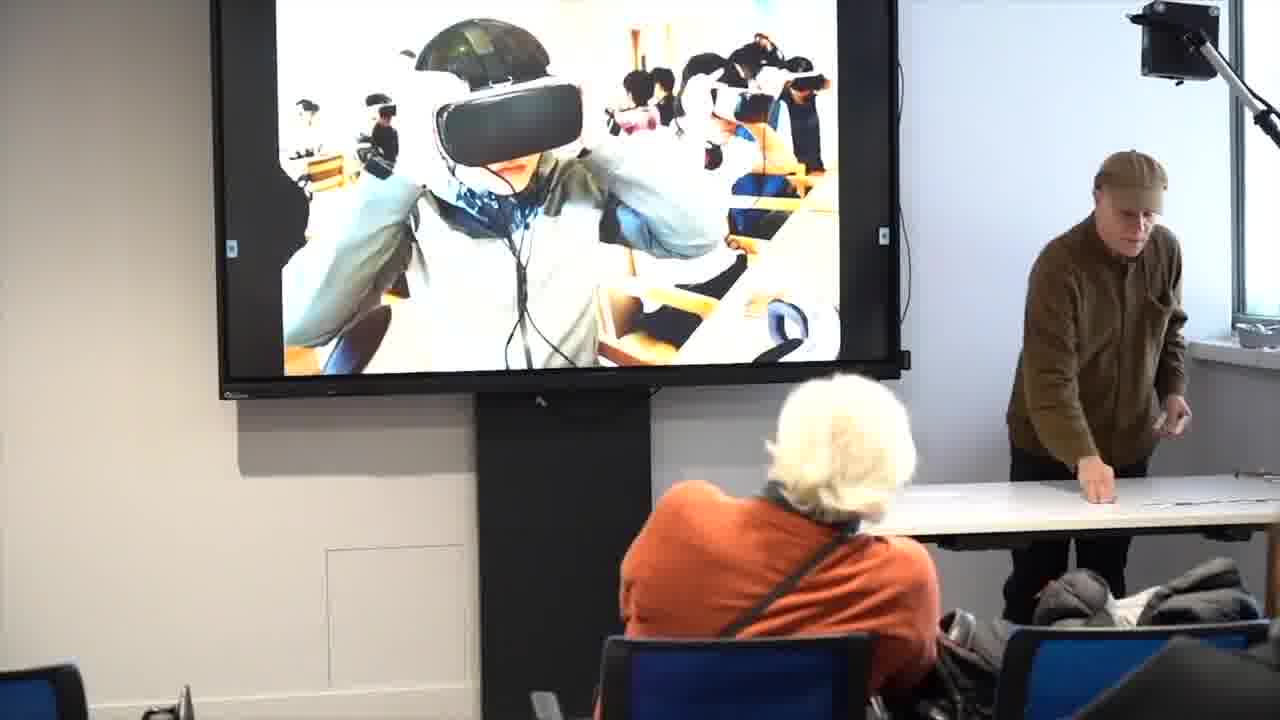
Or computation means having conversations with our furniture. So, we just don’t see anything. We don’t touch anything. We essentially regress to an oral culture.
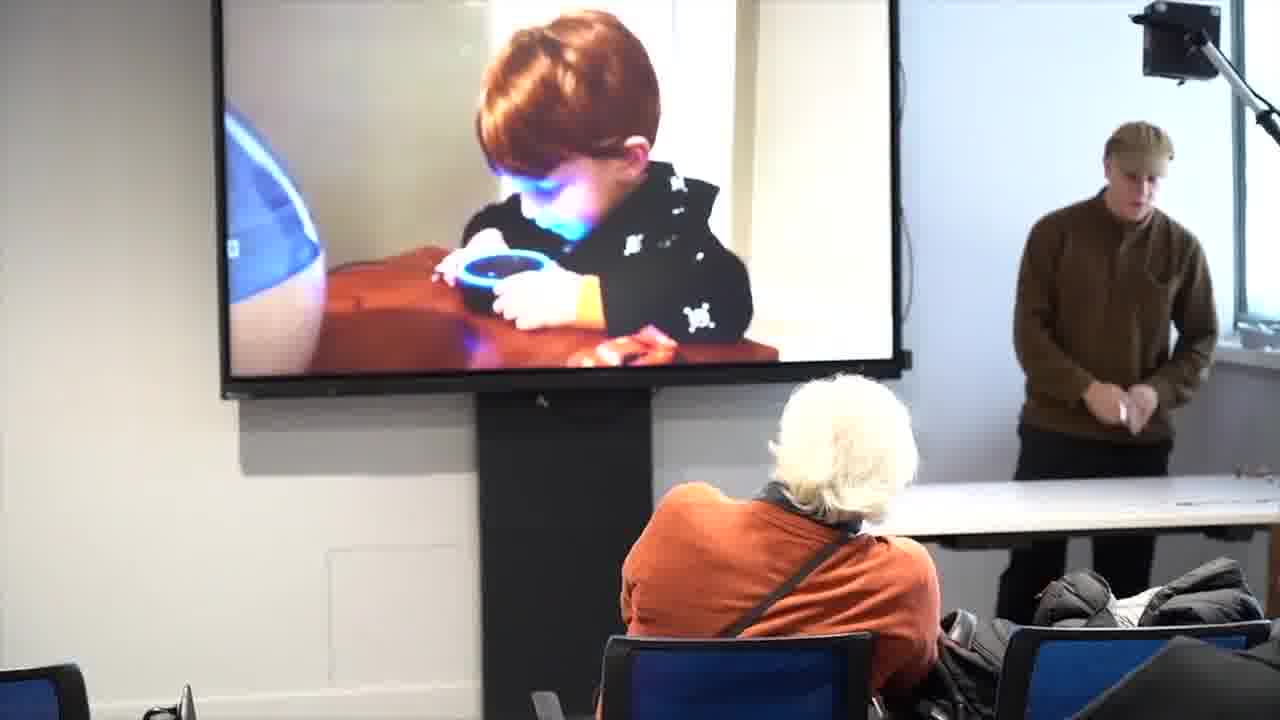
We don’t find these visions very inspiring.
The scenes that motivate the kind of computing that we’re creating look more like this. These are also people together in a shared space.

They’re working on a shared activity. They’re each doing a different part of the activity, but they’re all aware of what each other is doing.
They can use their hands to help each other out. They’re learning from each other just by working on this activity together and having conversations about it.
This is a communal environment. We want to create a form of computing which looks basically exactly like this picture. We call this “communal computing”.
An essential part of that is being present in a physical space, working with physical materials, using physical tools.
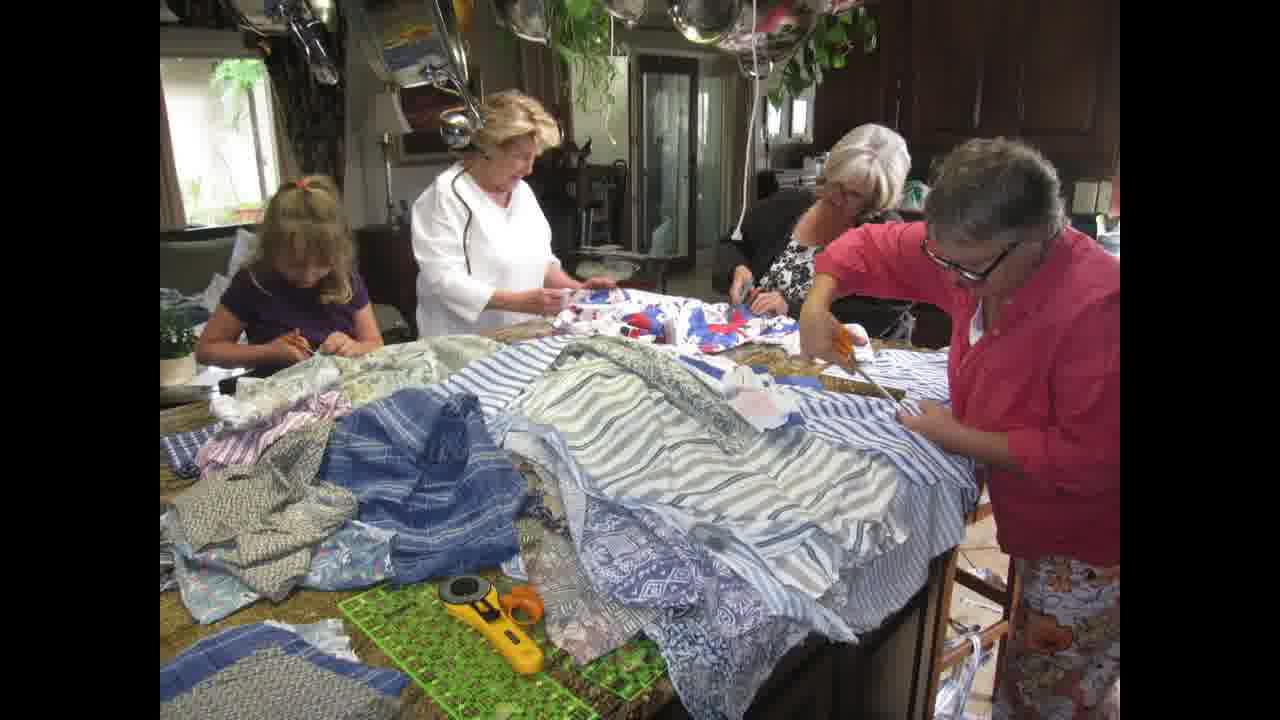
Because the real world is a shared environment that we can all agree upon. It’s ground truth.
And there’s just so many things you can do with physical materials that you can’t do with pixels on a screen.
You don’t have to code up a big simulation to manipulate these computational objects. The computational objects are just real things you can work with, with your hands.
So, a big part of this is taking advantage of the properties of the physical world to eliminate as much code as possible.
The third scene I’ll put up, these people are playing a board game.
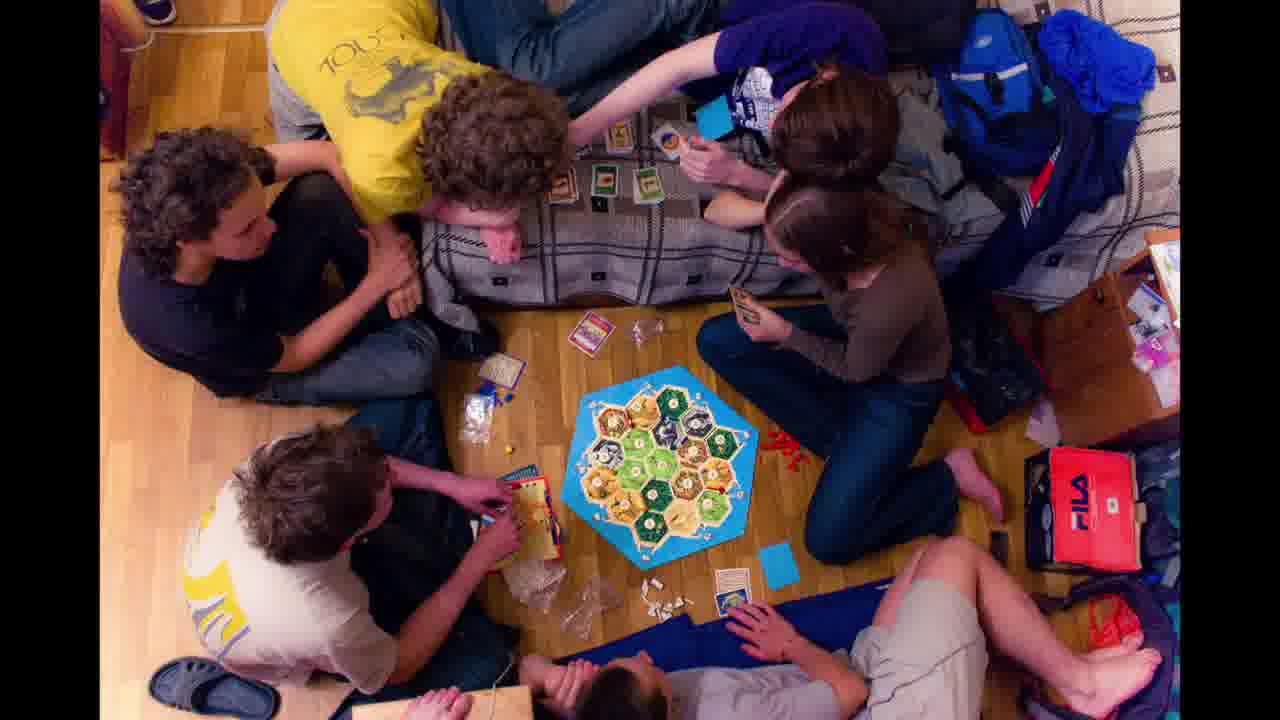
The way that a board game works is you learn the rules, and we all play the game according to the rules… until we decide we don’t like a rule.
And then we say, let’s play the game differently. Or maybe, let’s use these pieces for a different task. Or, let’s make up our own game.
In the real world, you have the freedom and flexibility to change the rules of the game. That’s because the rules are socially agreed upon practices.
This is completely different than a computer game, which you download from a developer, essentially download an entire universe with some fixed rules. You have to play within the rules that the developer has provided.
So, the three main ideas here: A communal environment, people actually together, learning from each other. Working with physical materials and physical tools to eliminate as much simulation code as possible. And pushing as much as possible into agreed-upon social practices rather than code.
And then, for the code that remains, you need to be able to change the rules of the game. So that means, in computation terms, anyone can reprogram anything at any time.
So that’s a little bit of what we’re trying to get to.
Communal computing
Like I said, we developed this form of computing within a community space that we started. I’ll show some scenes of that.
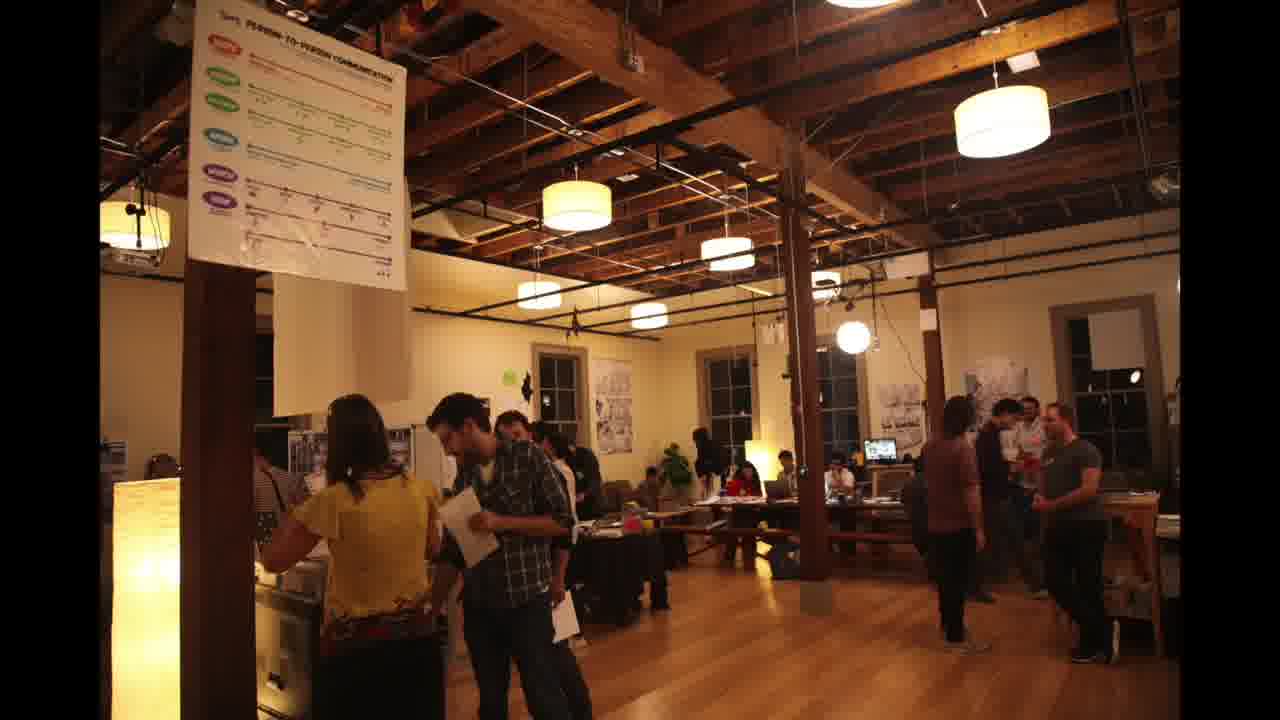
The main thing is to look at the way that people are relating to each other.
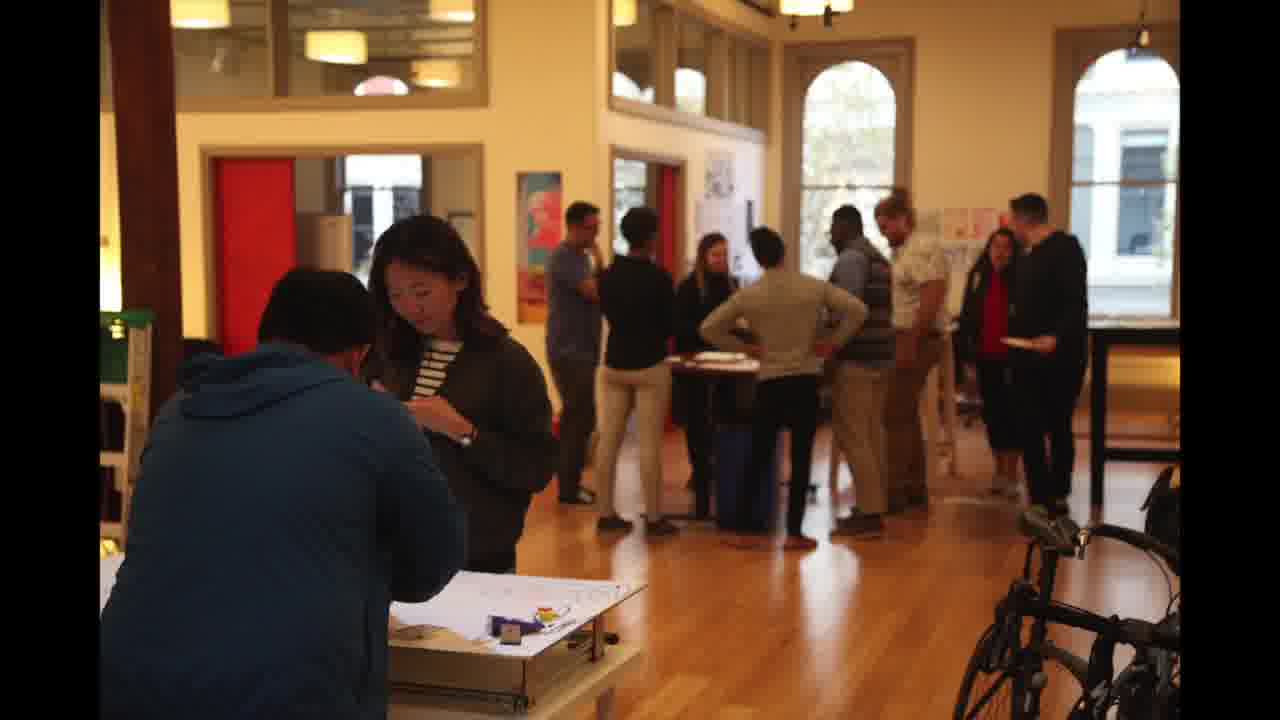
There are tables where people are gathering around and looking each other in the eye. They’re all getting their hands on things. There are physical crafting materials. There’s paper and tape and scissors.
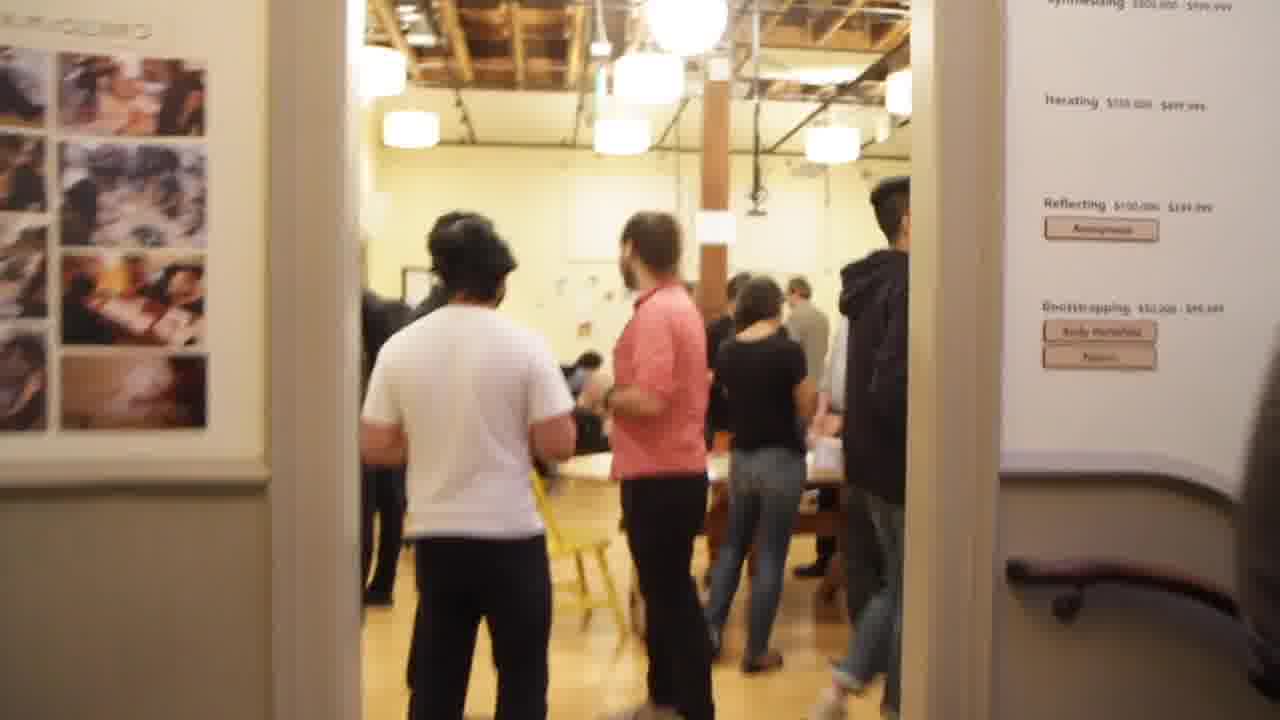
What’s maybe harder to appreciate here is that this is all “computers”. All of these are computational activities. Everything that people are doing on these tables are computational activities. But there are no screens here.
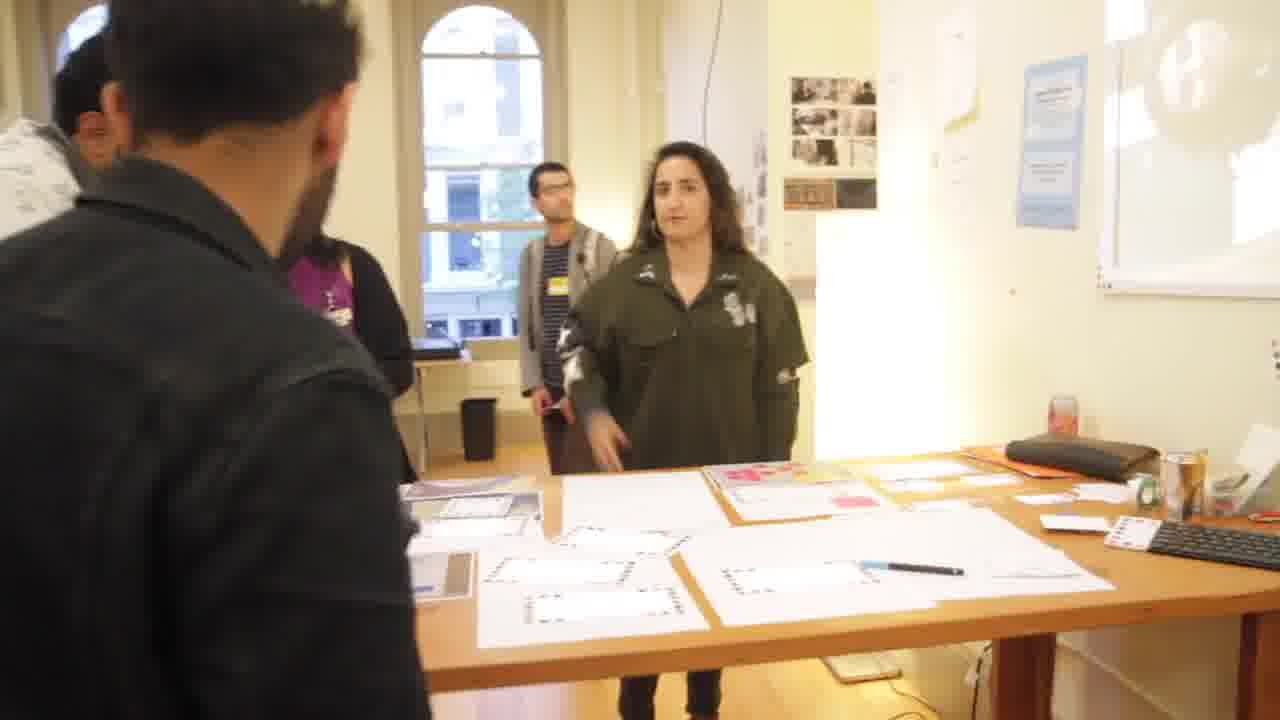
Computation is on the table. It’s on the walls. You’re going to see some computation on the floor. They’re hanging out on the floor doing computational activities.
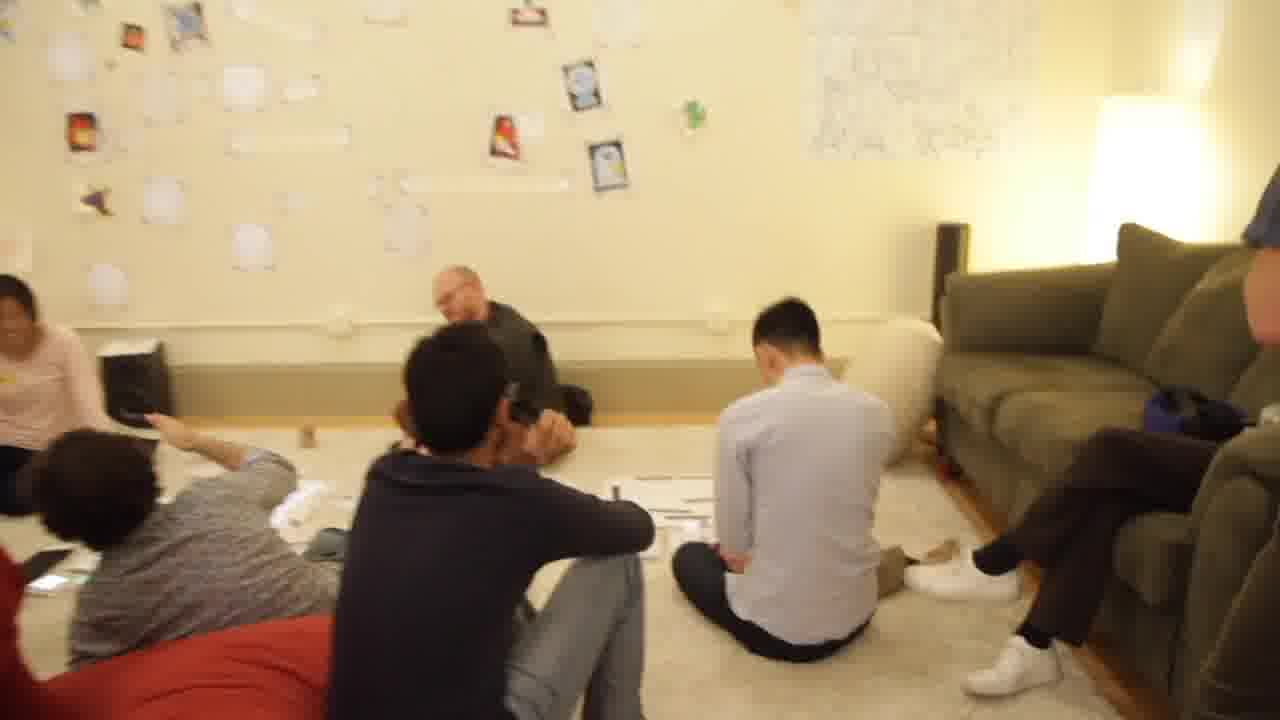
In a bit, I’ll go into what exactly these things are. The main thing to pay attention to right now is just the posture that people have towards each other.

He’s showing a sound synthesis toolkit here on this table. It’s made of these little pieces of paper. Everyone is kind of gathering around and looking at it. Everyone’s putting their hands in there, trying it out. [more]
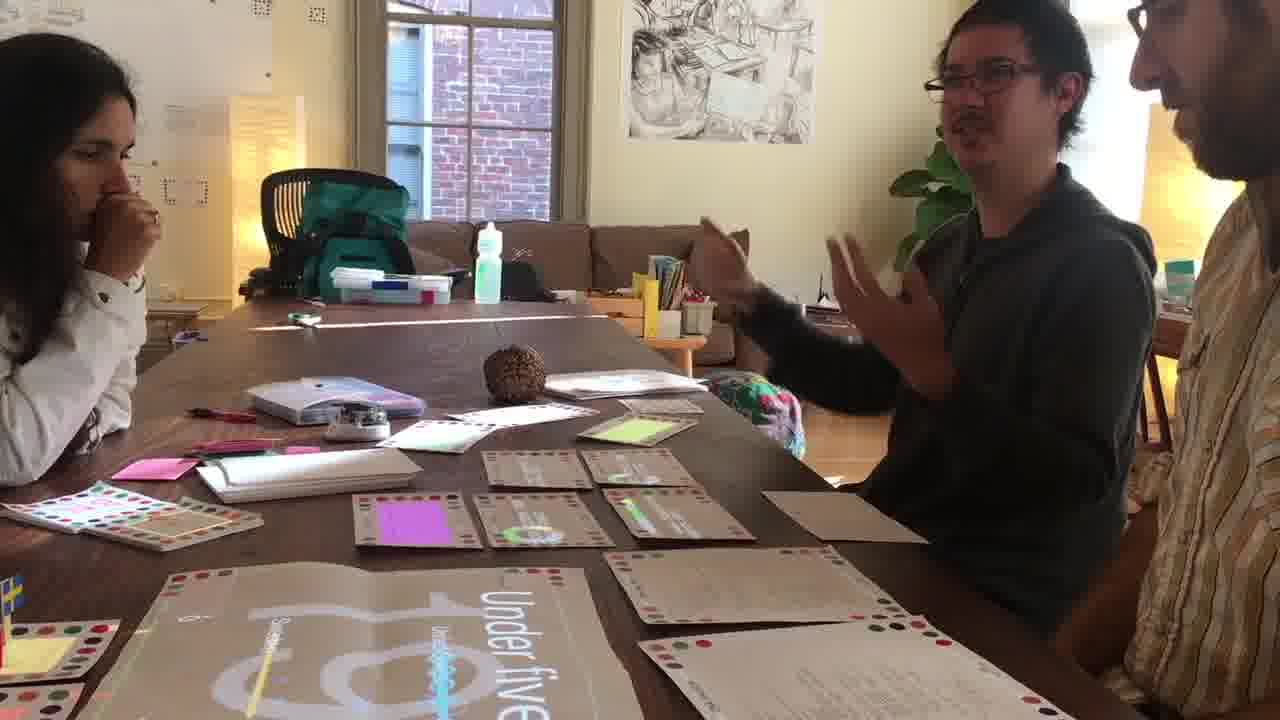
This is a molecular biology simulation, a recombinant DNA simulation, that’s just on the table. They’re having a conversation about it. They’re talking about it. They’re pointing at things that are on the table. They’re looking at each other in the eye. They’re actually present in the same space, but they’re engaging with a computational model. [more]
Here, these people are at a workshop where they’re going to tell family histories, essentially. [more]
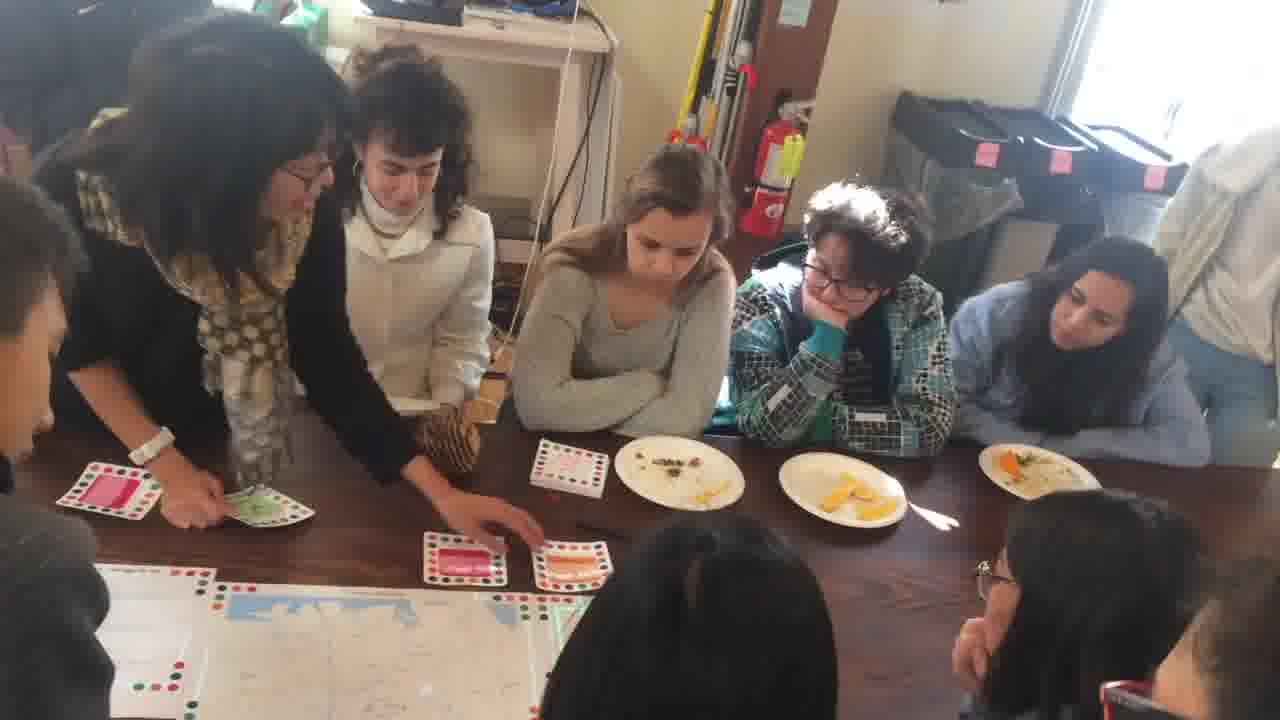
They have digital photos and videos about their ancestors, and there’s a map, and they’re going to show the paths of their ancestors in pictures and tell stories about them.
They’re learning how to do this activity on this lunch table. There are the plate from lunch, and these are the physical objects that they’re going to be using.
So, people gathered together, learning together.

This is a visualization, or dataset, containing population and demographic data for different countries at different times. [more]
The people at this table want to have a conversation about global economics, and they’re able to do it in a way where they can put data on the table and explore that data together as they have their conversation.
There’s room to spread out, put lots of things on the table. [more]

All the things on the table all see each other. They’re all part of the same activity.
It’s really easy to make activities that span an entire table, that span an entire room, or entire building.
One funny thing that happens in this environment is collaborations happen spontaneously.
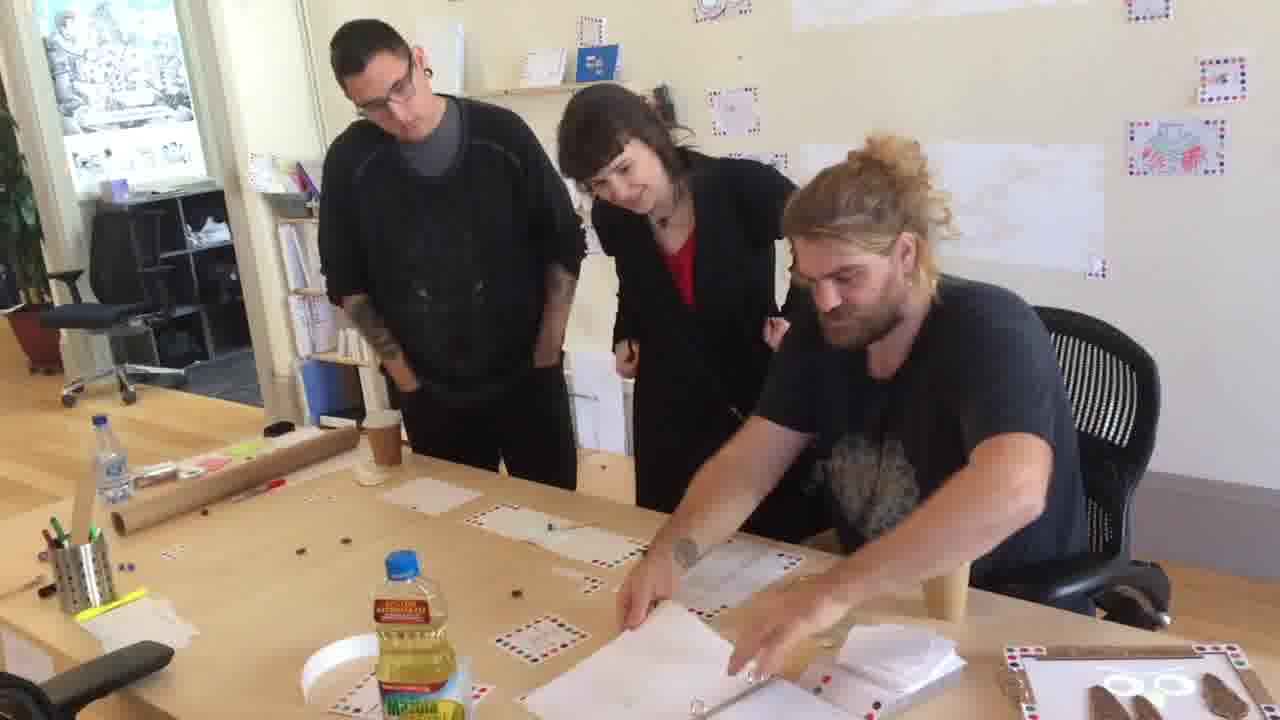
Isaac here was working on a project. Some of his friends came by and said, what are you working on? And he just showed it to them right there on the table. And then what’s going to happen is they’re going to sit down with him and start working together. [more]
And that happens all the time, because everything is out and visible. People walk by, they sit down with you, they start working together. These social dynamics never happen in an office filled with screens. The social dynamics are completely different here. [more]
These are adorable children, because you have to show adorable children. [more]

Low barrier to entry. Children start out playing with things that are lying around. And then they want to change them. So they start changing the program, and they essentially start making their own projects right from the start.
This presentation
I’ve been showing you this presentation, you might have noticed, with these cards. This is just how I decided I wanted to do this. I have these cards here, which have photos and videos on them.

I’ve just been putting down cards to show them on the big screen.
The way that works is, I have this thing right here. This is a computer program. Basically, everything that’s on the desk is a computer program.

This is a little computer program that says “Show last media card”.
If you read this piece of paper, it says, almost literally: “When you’re on a table, and there are cards on the table, look for the card that’s at the bottom-right, and show that on the big screen.”
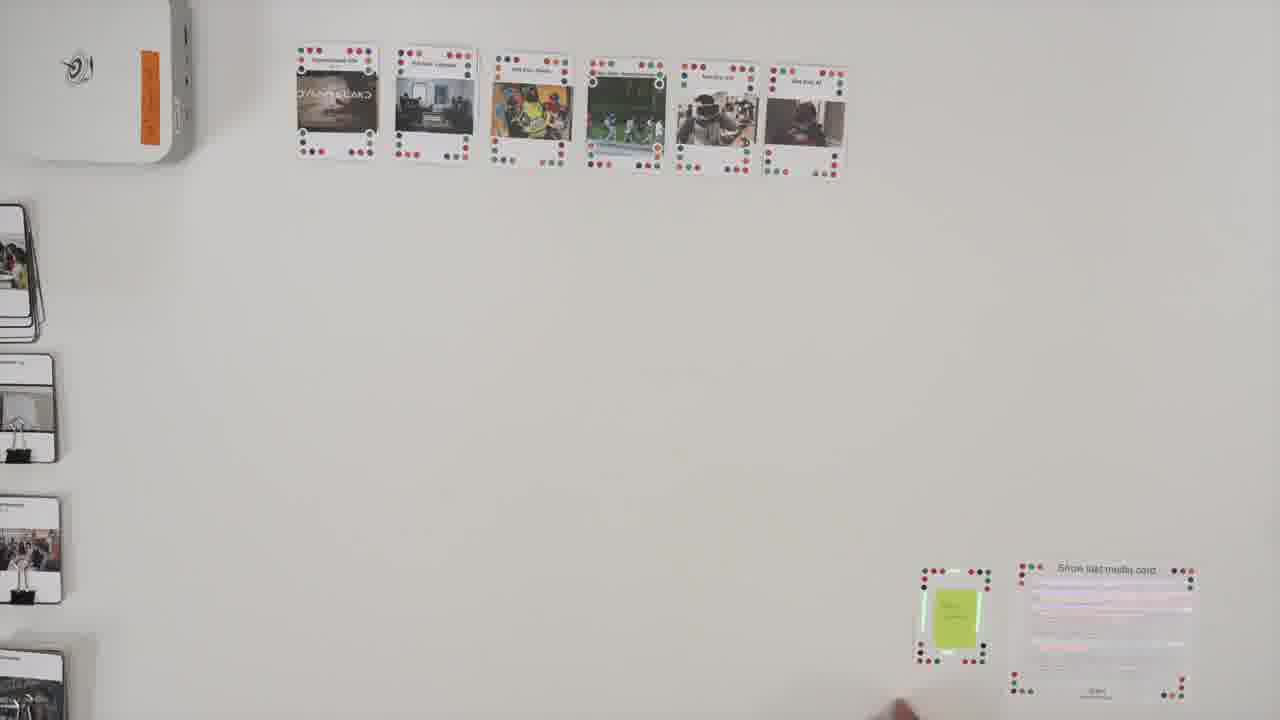
Right now, the one that’s at the bottom-right is a special card that says “Show camera”. So instead of showing its own photo or video, it’s showing what’s coming from the camera feed, so you can see what’s going on here.
Whatever’s at the bottom-right is what shows on the screen.
So, this is my presentation software. It’s 25 lines of code.
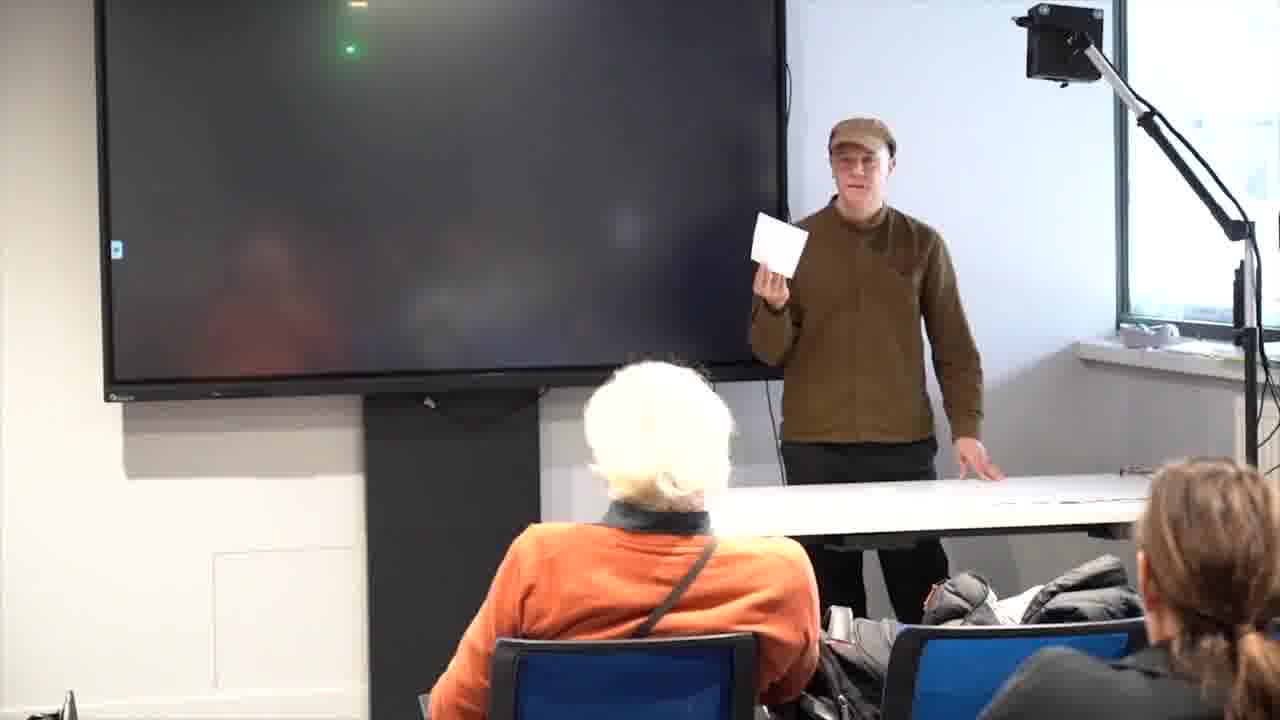
Microsoft PowerPoint is maybe 20 million lines of code. You don’t need it. And you don’t need a giant tech company to make it. Anybody can learn how to make this for themselves.
In fact, I’ll make one right now.
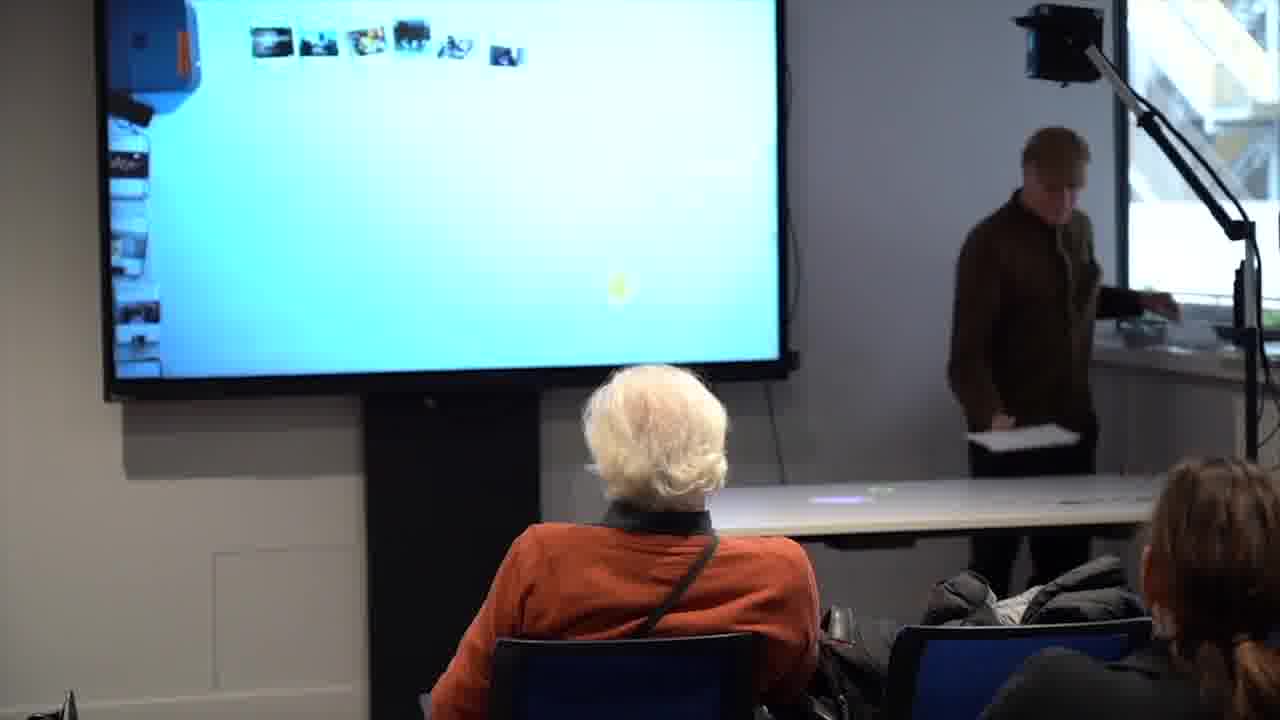
Just to show you really quickly how programs are made, I have a blank sheet of paper here. Someday we want to actually be able to handwrite the programs onto the paper, but for right now, I have a keyboard. I just point the keyboard at the paper.
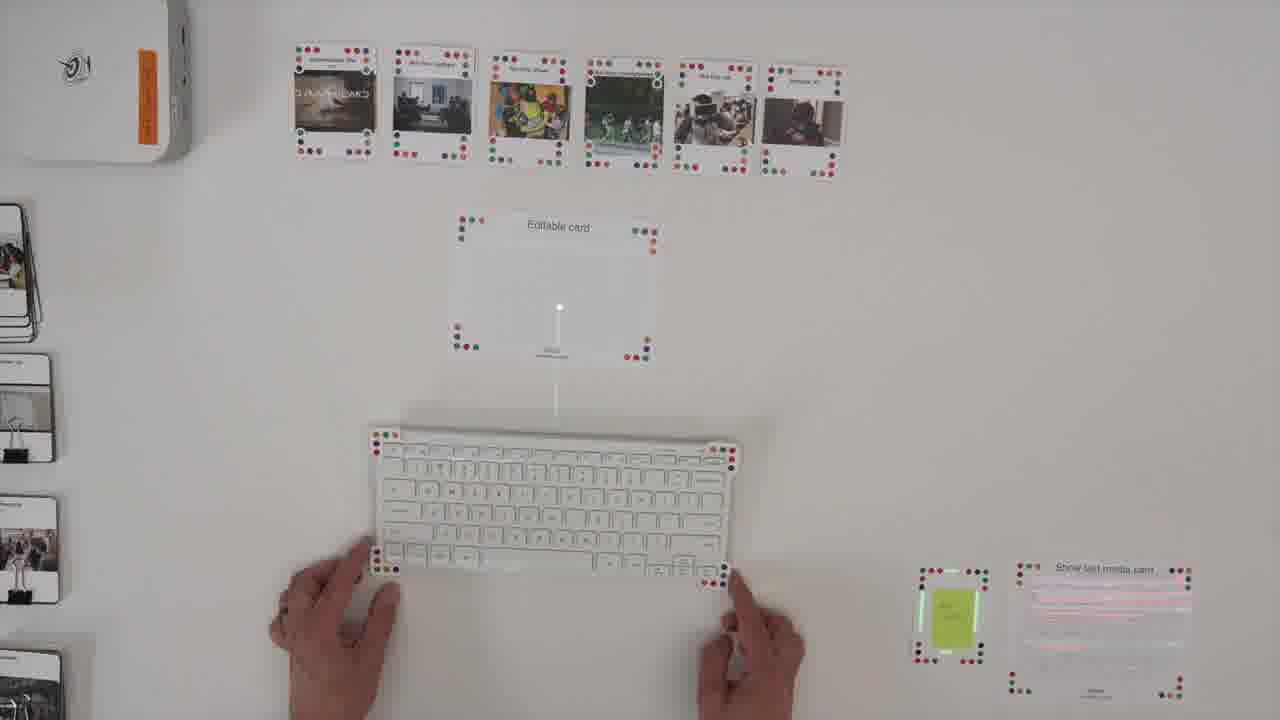
If I’m not pointing the keyboard at the paper, then if I type, the letters just go off into space. But I want them to go into this piece of paper.
I’m going to type a little program here. Basically, I’m going to tell this piece of paper what to do.
I’m going to tell the paper: when you point up at an object (basically, when an object is above you) that object should be highlighted green. So now, whatever object is above this piece of paper is turning green.
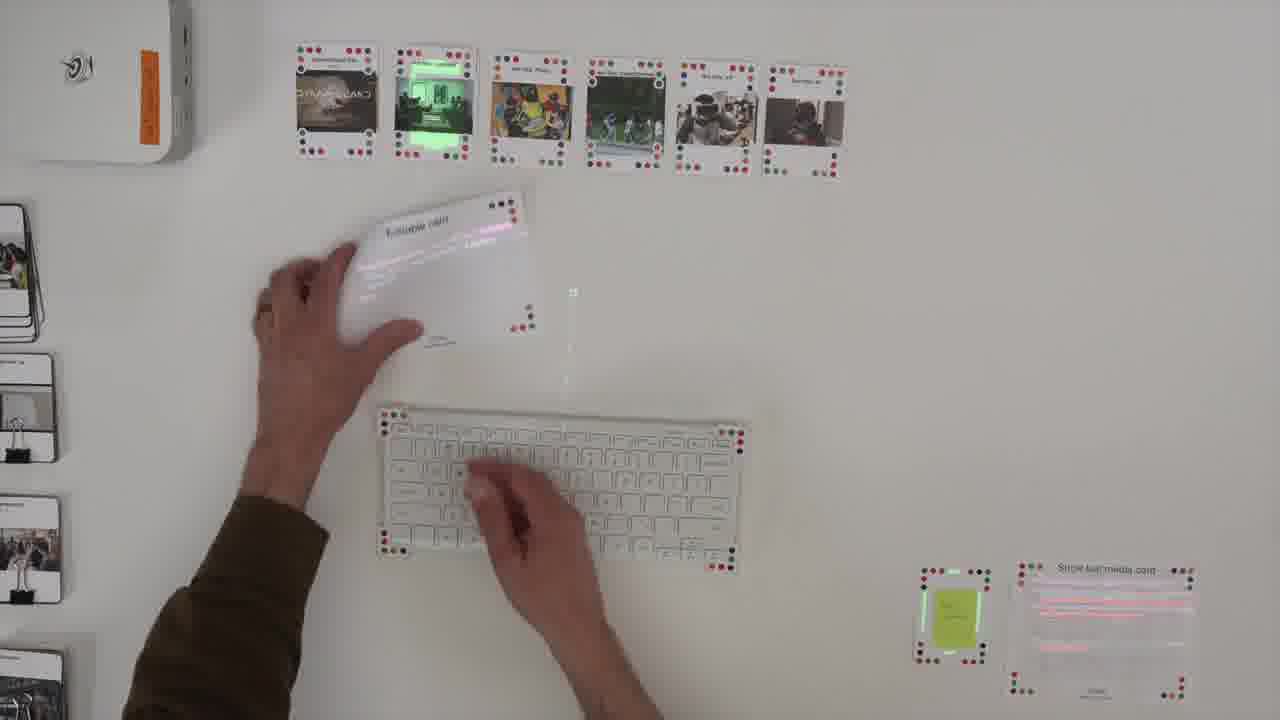
I can make my presentation software turn green. Or I can make the keyboard turn green.

This is a very simple program. It’s two lines of code. But what’s happening here is the basis for everything that I’m going to be showing you. It’s a physical object that’s establishing spatial relationships with other physical objects in the real world.
That’s essential, because we exist in the real world. We can manipulate physical objects with our hands. We understand spatial relations. We can see them. The computer sees the same thing that we see.
Physicality
Maybe one step up from that particular example, this is a particle simulation. This is the program, and it’s drawing dots on itself, simulating particles. [more]
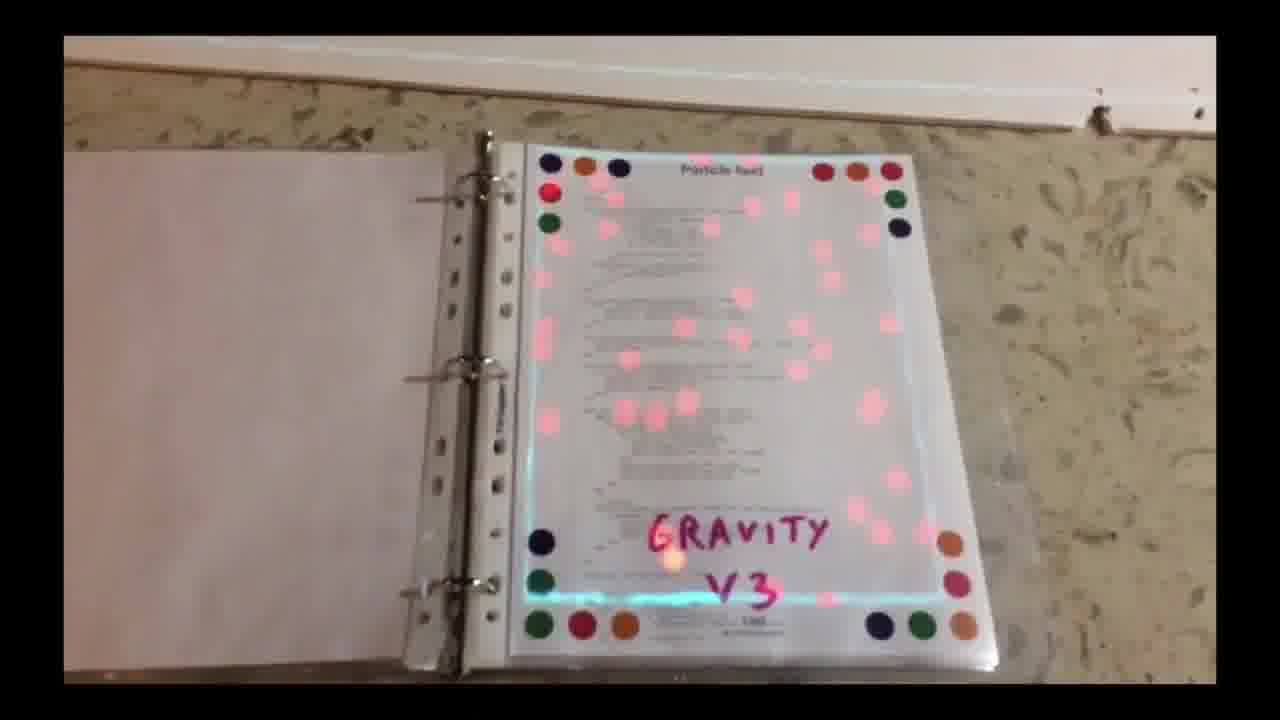
He was going through kind of different versions of the program, and he just collected them all into a binder. He made this little book of programs, put a whole bunch in them, and put them in a binder, and now you have a book.
These are drawing on top of the page itself. But then he decided he wanted more room, so he made one that draws on whatever’s above it. So, objects that see other objects physically around them and affect the real world.
And it’s really easy to make books. Here’s a video album from a class field trip to the space. They’re just stuck in a binder. [more]
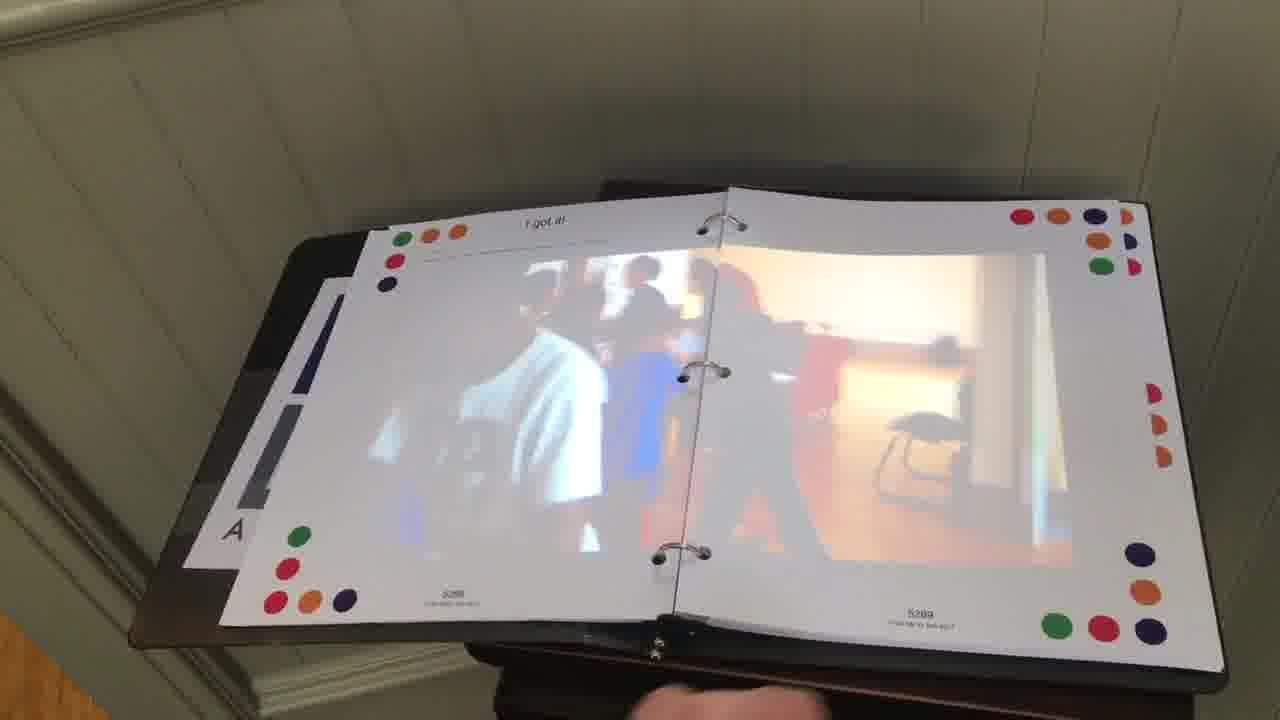
Flip through the pages, you have the videos on the pages.
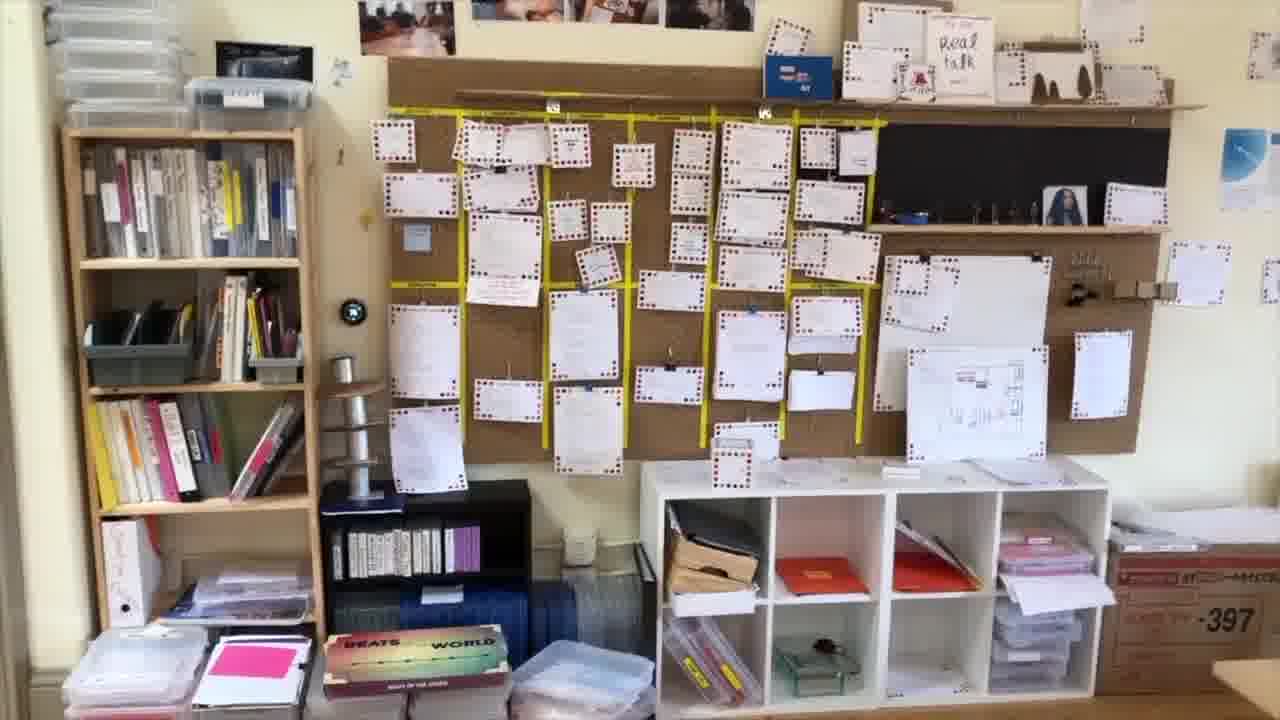
Because programs are real things, you can arrange them in space. You can put them on a tool wall. You can put projects on a shelf. You can grab a project off the shelf and open it up when you want to use it. Everyone understands what it means to have things on a shelf and grab them and move them around. [more]

This is a rhythm sequencer, a drumbeat sequencer. They’re making different drumbeats by moving these little tokens around. [more]
Then then they decided it would be more fun to hang out on the floor and make drumbeats. So now they’re spread out on the floor. Everybody’s working together, making sounds.
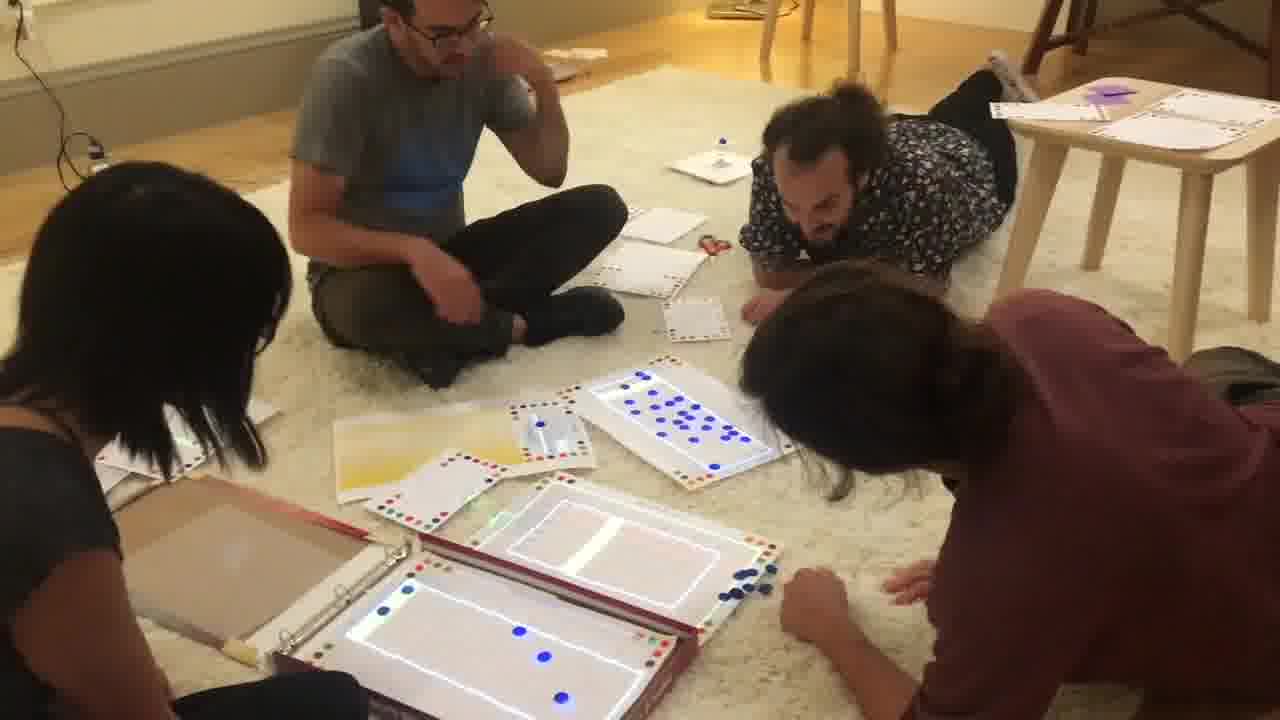
And the software is this. This piece of paper right here is the entire code for this activity. This is not a user interface to a codebase in some GitHub repository. The program itself is present in the environment. It can be changed just like anything else.
Working with physical materials means that you can use physical scale models.
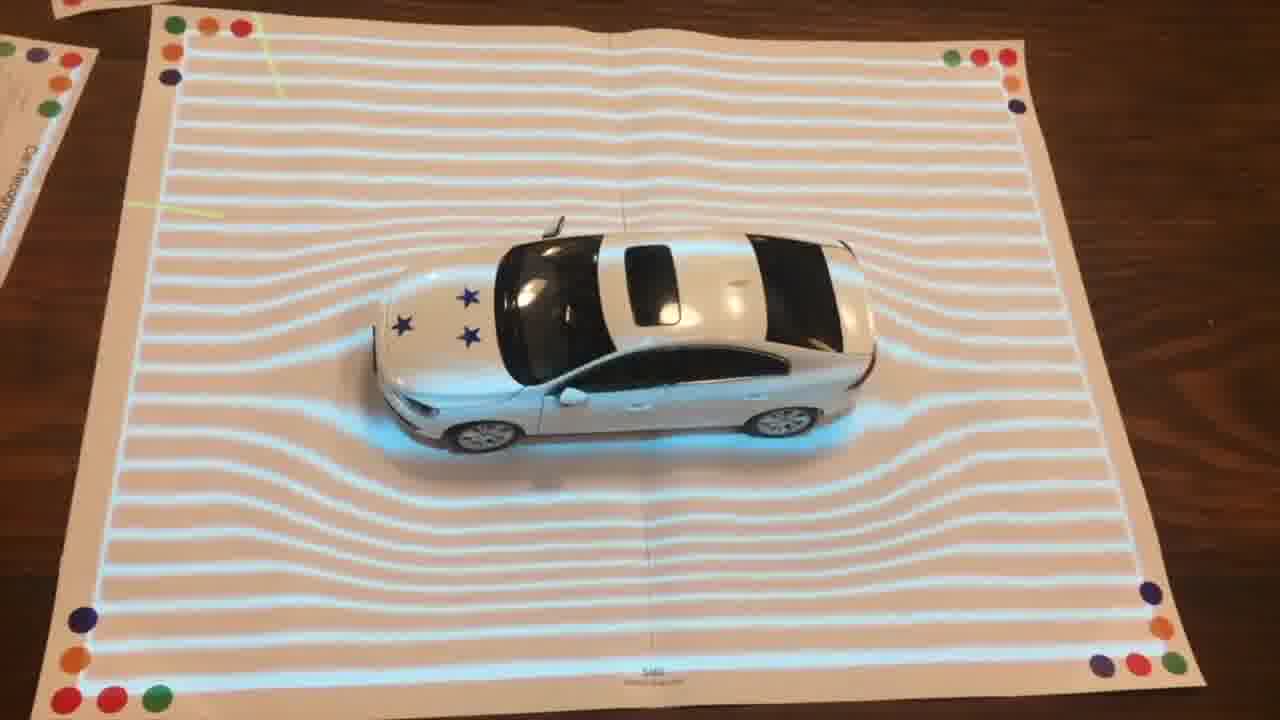
This is a simulation of wind flowing around a car, which we made because some folks from a car company came over. [more]
I like this wind simulation a little bit better. This is for architectural models.
That page simulates the wind, and that page finds the buildings on the table. As I put buildings into the scene, you can see the wind flowing around them.
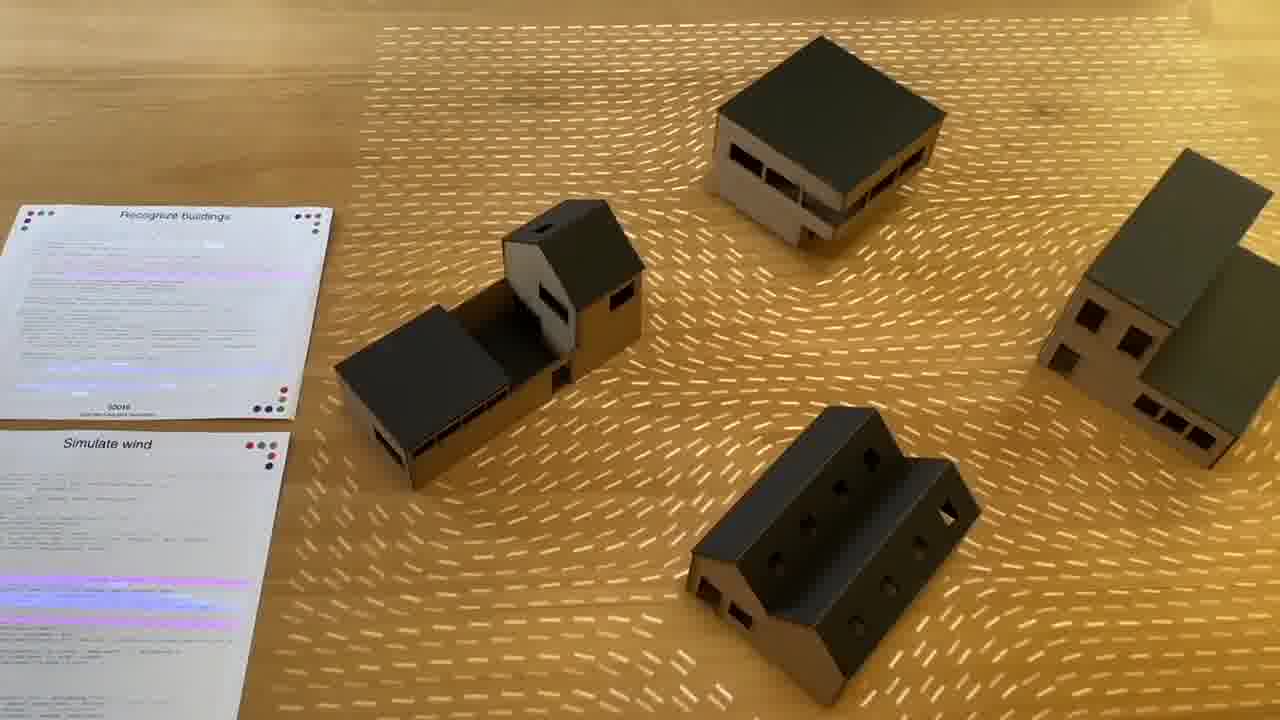
So, working with real physical objects that you can hold in your hands, that exist in situations that we understand in the real world.
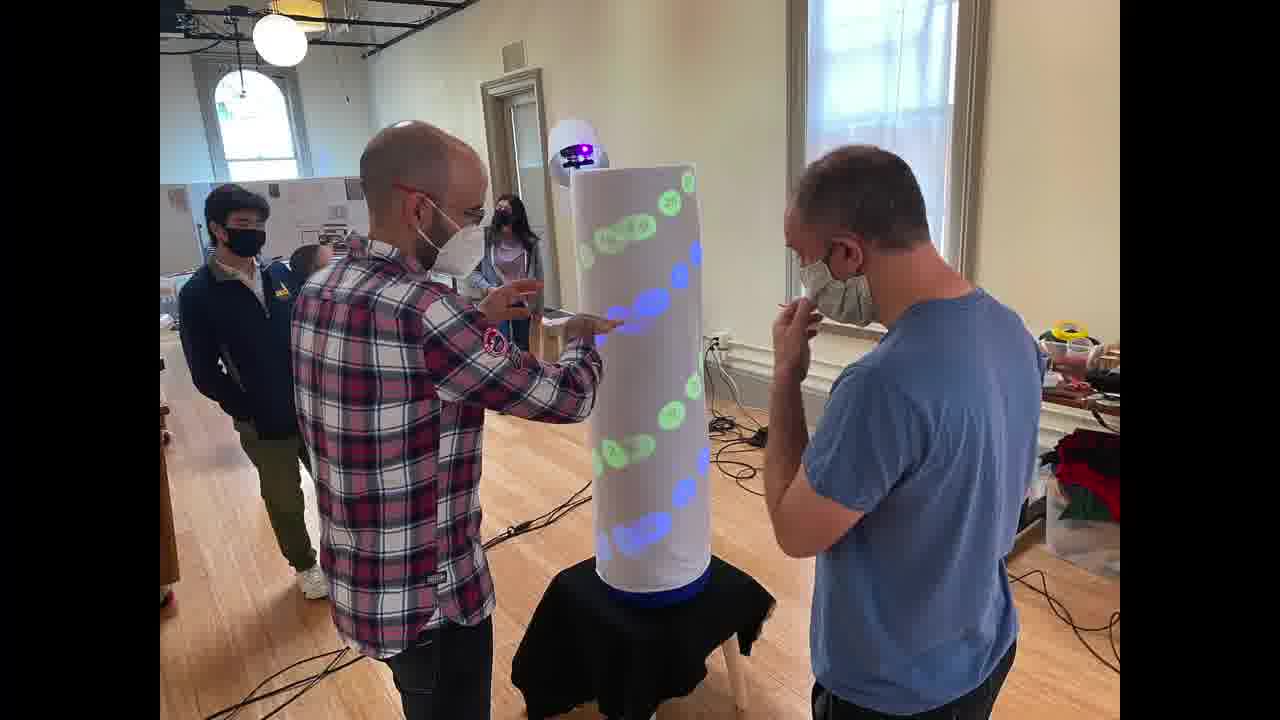
They don’t have to be small. These are some bioscientists, and this is a model of a DNA helix. This is showing where the bases are on the DNA helix. [more]
This is a model that’s life-size. You can walk up to it and understand a DNA helix at the scale of your own body.
For a smaller scale, these are also DNA helices. By moving them around in space, we’re actually adjusting this 3D rendering here. [more]

You can see scale models on the table, but also understand them in three-dimensional space. So, scale models at human scale, putting them on the table for hand scale.
You can put things on the wall. This was a workshop where some teachers were discussing educational ideas. [more]

They represented their ideas in computer programs which they put up on the wall. Then they found paths towards each other to make this mural that connected the ideas that the people at the workshop had.
Then they gave a presentation where each person came up and talked about their ideas in the context of everyone else’s ideas. They were all connected using the computational system.
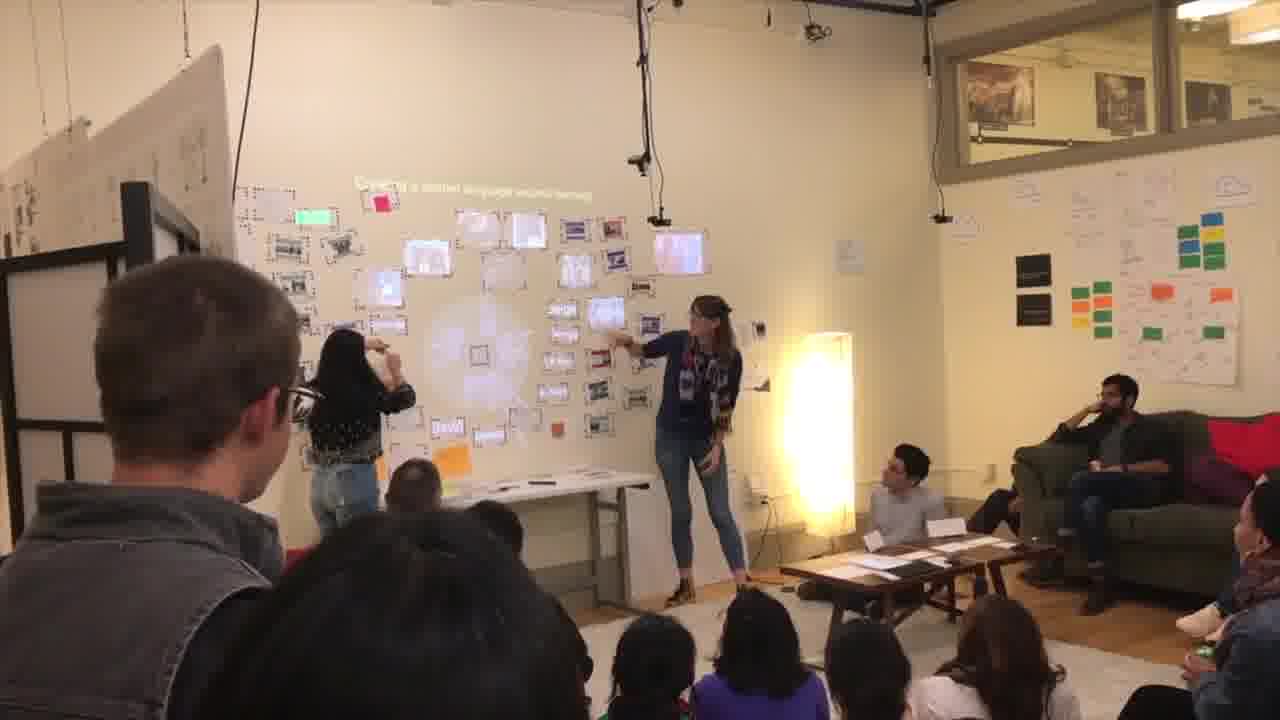
Maybe an extreme idea for integrating computation into physical materials is timber framing.
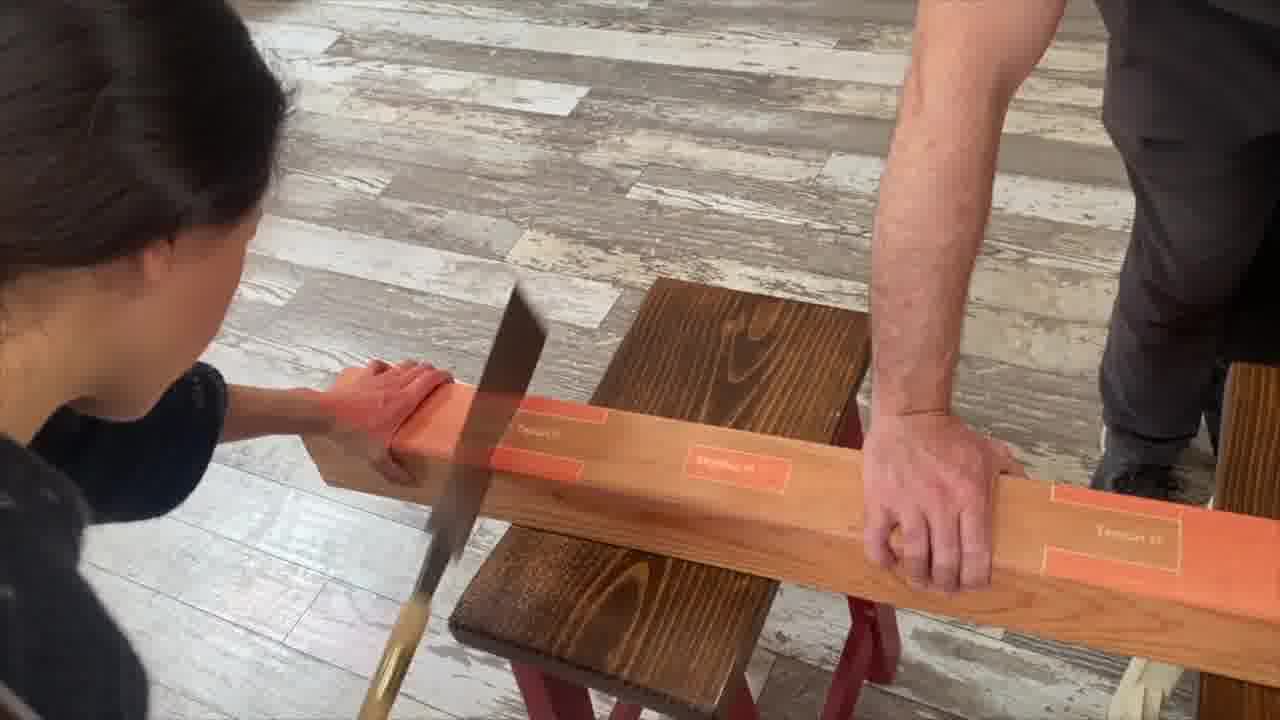
Here we’re cutting a beam to be used in a timber frame. We have a computer program generating where the cuts should be, and projecting onto the wood so you know where to cut.
So, computation integrated into physical space, physical materials, real-world activities, not just things that are up in a screen.
Like I said, the programs themselves are real physical things. This is my presentation software.
And the operating system, the computing system that makes all this work, at the community space, it was in the form of a bulletin board. [more]
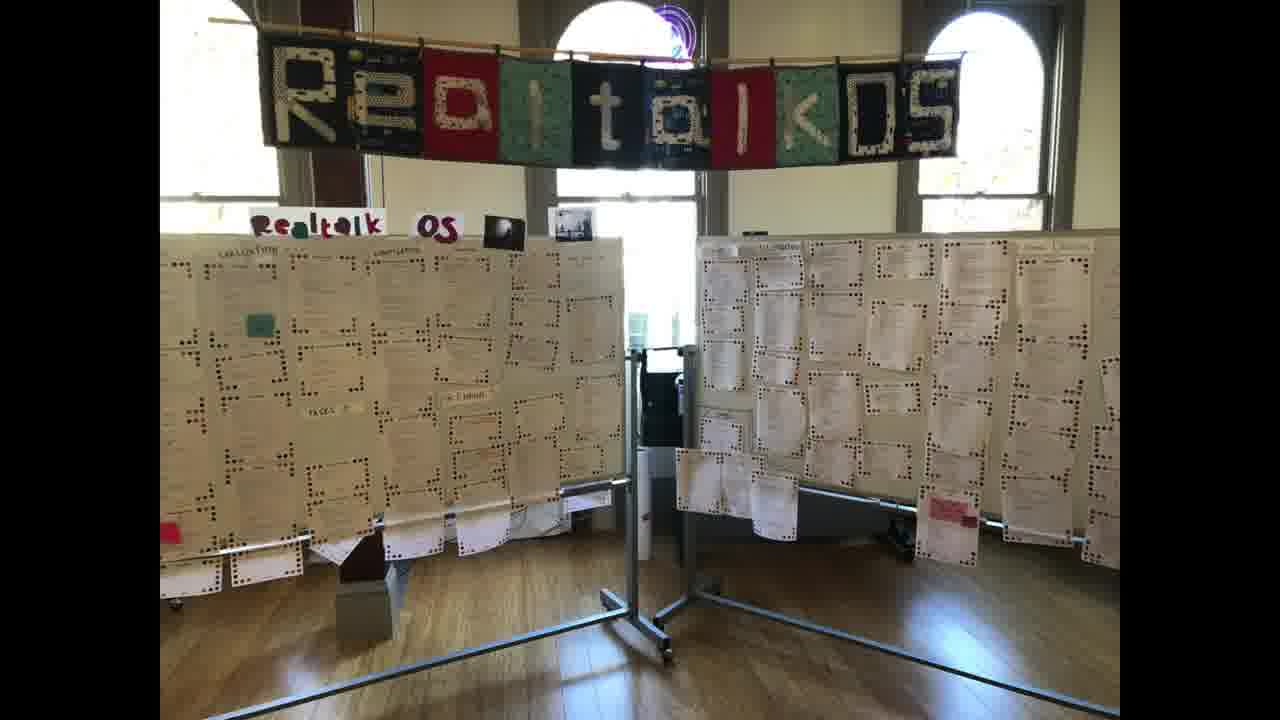
These are all the programs that make the system work. People would come up here, read them, swap them out, edit them, in a very communal manner.
A later version tried to be more of a poster gallery. Each one of these posters is a subsystem that, again, everybody can see and anyone can change at any time. [more]

Because I had to fly here, I have the travel version of our operating system, which is in this binder. I also have some tools and stuff in this binder, in these little pockets. [more]

Every line of code that we’ve written physically exists. It’s in a place where you can get to it with your hands, put it on the table, change it, gather around with other people, talk about it. It’s not hidden away in some screen or some directory.
The last thing I’ll show, before we get onto cities… The community space that we were running closed down for COVID. So we started moving into a collaboration with scientists, to go really deep on one particular topic. [more]
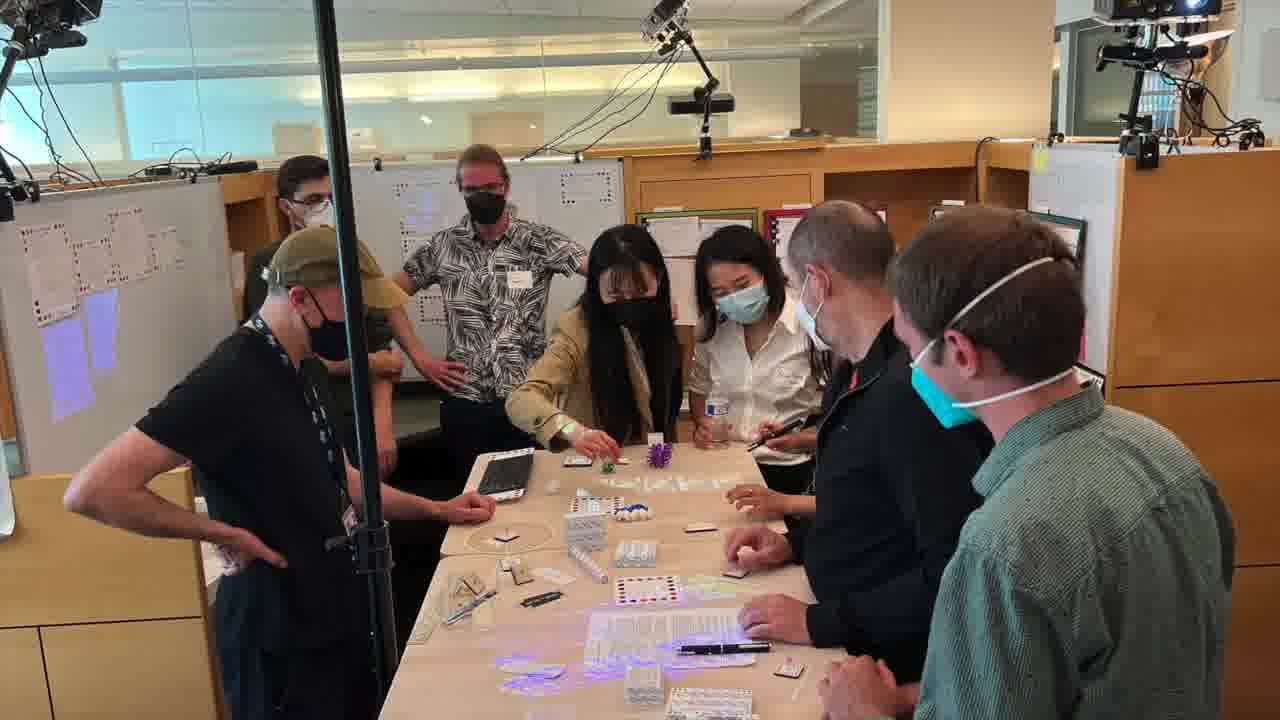
I’m not going to go into too much detail about that. But scientists, generally, all work inside their own screens. They’re not aware of what anybody else is doing, and they can’t really work together very well.
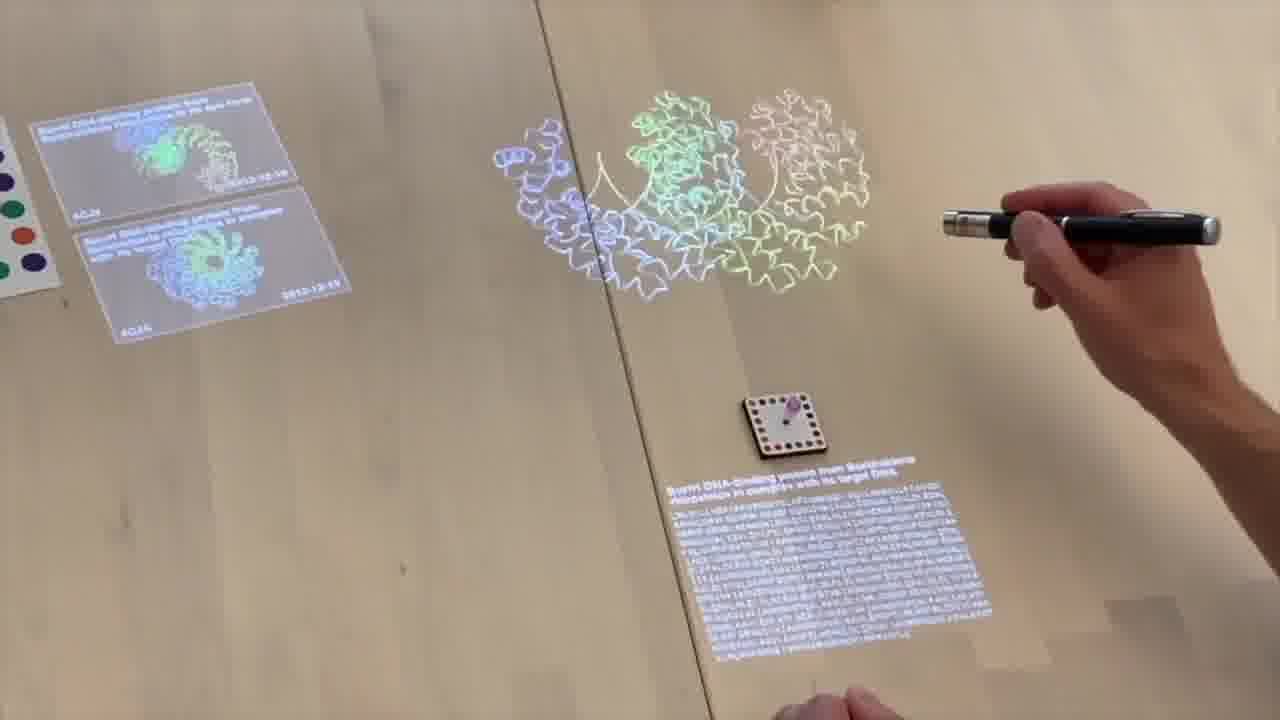
Here are some examples of editing proteins on the table, modifying and splicing proteins, and looking at what the experimental data will look like. [more]

Pinning up programs that analyze microscope data. [more]
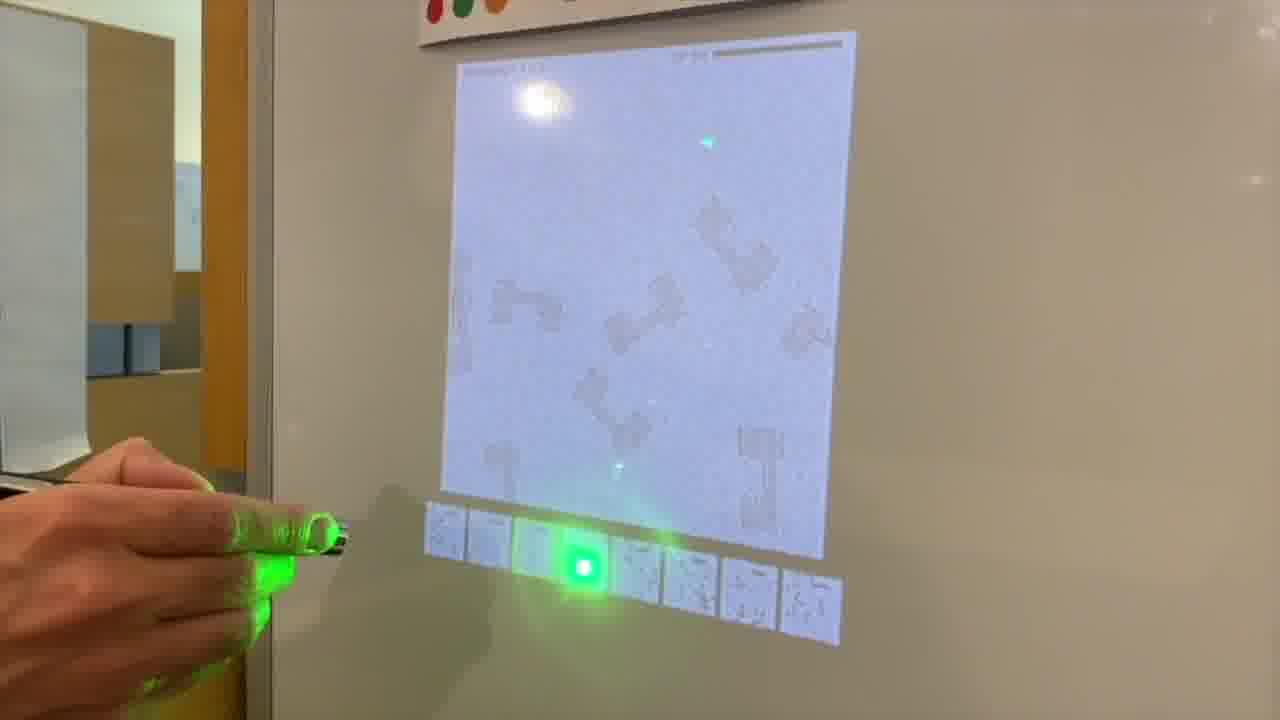
Integrating computation into the wet lab, working with test tubes and physical materials. Because if we want to integrate computation into timber frames, we also want to integrate it into actual biological materials, enable the scientists to actually see what they’re working on. [more]
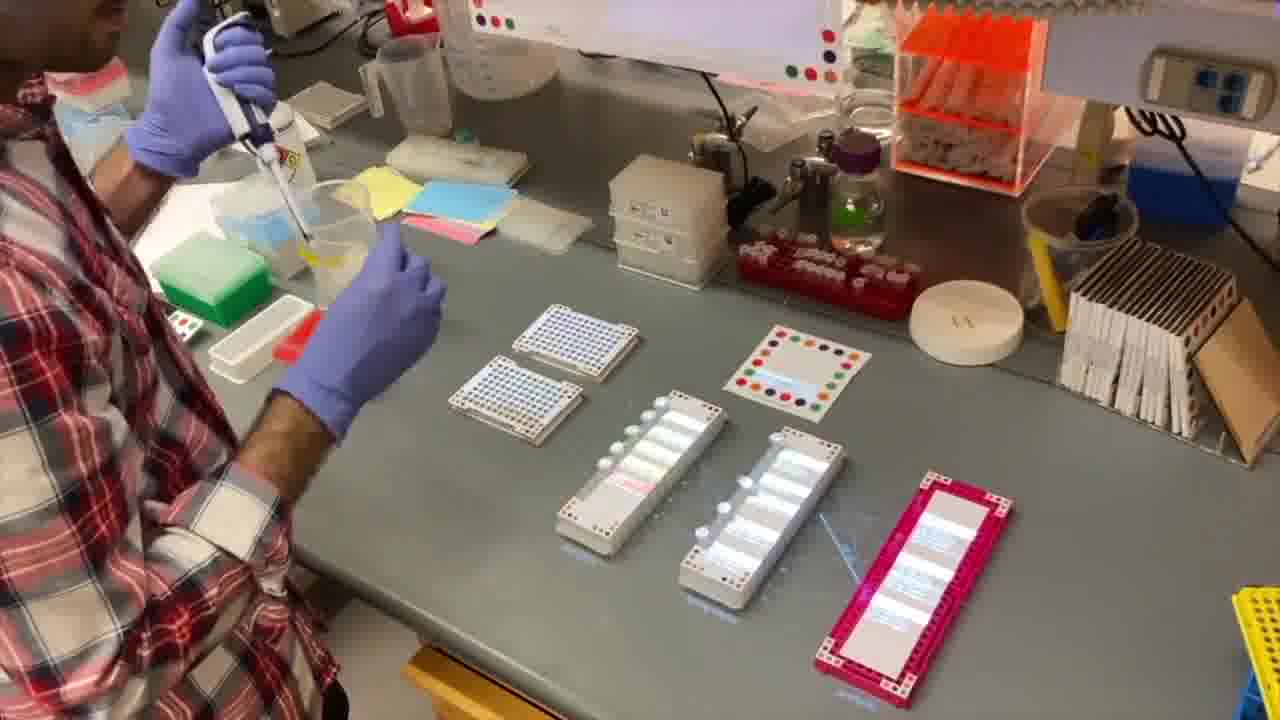
That’s maybe enough of a background on what this computing system is all about. So let’s talk about cities.
Like I said, we’ve been interested in how computation can serve public life and be integrated into public spaces for a long time. We’ve never had a chance to do that work before. So I don’t really have anything concrete to show you about cities.
But I thought what we could talk about are values. What is important to us in the built environment? And are those things reflected in our computational environments?

For each of these seven values, or contrasts, or tensions…

I want to talk about how they’re reflected in the city, in the built environment, and how they could be reflected in our computational environments. How we can integrate computation into the built environment to uphold these values that we care about.
Globalization
The first one I’m going to talk about is globalization versus local culture.
I have to start with McDonald’s as the international symbol of globalization.

I think we’re all familiar with the concept of how, if you go into any city and you see the McDonald’s and you see the Starbucks and the H&M, every city starts to look alike. The cities lose their distinctive character.
We don’t necessarily have to say this is bad or good, but it’s something that we can discuss and debate. It’s a concept that is understood in urban design, the concept of globalization.
I think it is maybe less widely acknowledged that there’s a very similar analogy in computational environments. In the same way there’s a McDonald’s on every corner, there’s an Instagram on every phone.

Instagram was made by a few guys in California, and now it patterns the social interactions of people in every country in the world.

The one that gets to me the most is maps. You’d think that if anything was supposed to be local, it would be a map. A map of a neighborhood should be designed by people from that neighborhood, not an algorithm written by a tech company.
At least, in the built environment, we have the concept of local culture. We know what local culture means. We know what local values are, and that we want to respect them.
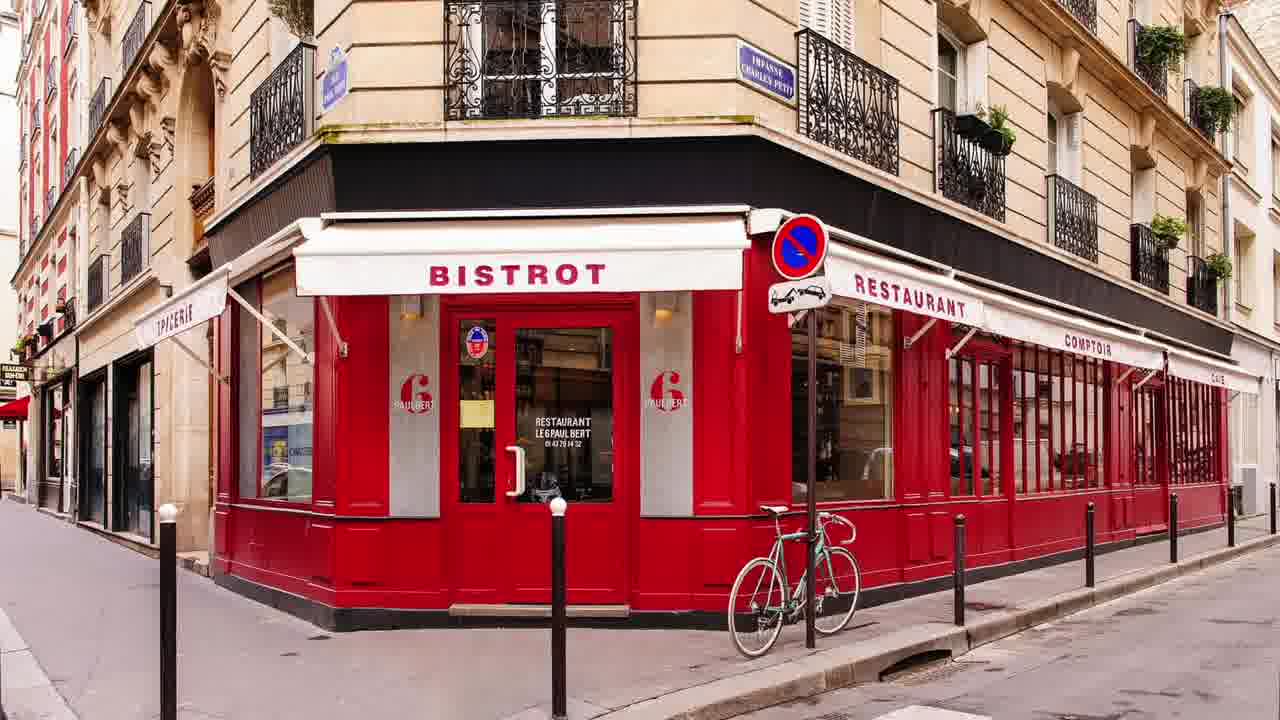
We have the concept of local craft. Local skills, knowledge that’s local to the place, local values.

In computing, there really is no such thing as local culture. There are subcultures. But there’s not really such a thing as a style of computing that’s specific to a city or a place.
A big part of that is because computing is made of mass market products. Products that are distributed to everybody, everybody downloads them and uses them identically.
What we’re trying to do with our form of computing is essentially the opposite of that. We want to create a form of computing that is not a product, but is a practice that is learned and taught.
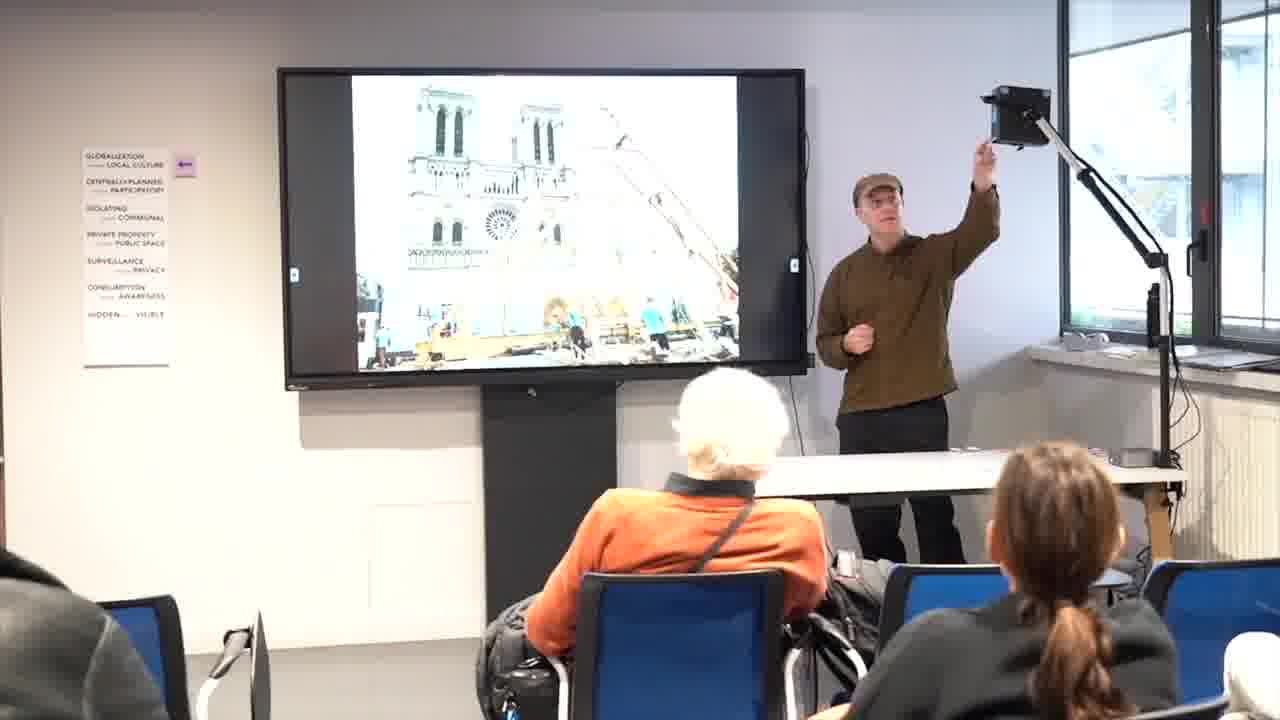
You can’t buy this. You can’t download this. You’ll never be able to buy this. You might be able to learn how to make it yourself.
Where we want to get to is where every local community makes their own computing system for themselves, for their own needs, their own values. Different communities, of course, will share ideas. But it’s part of a local practice.
We’ve got a ways to go before that’s practical, but I’ll show you an example.
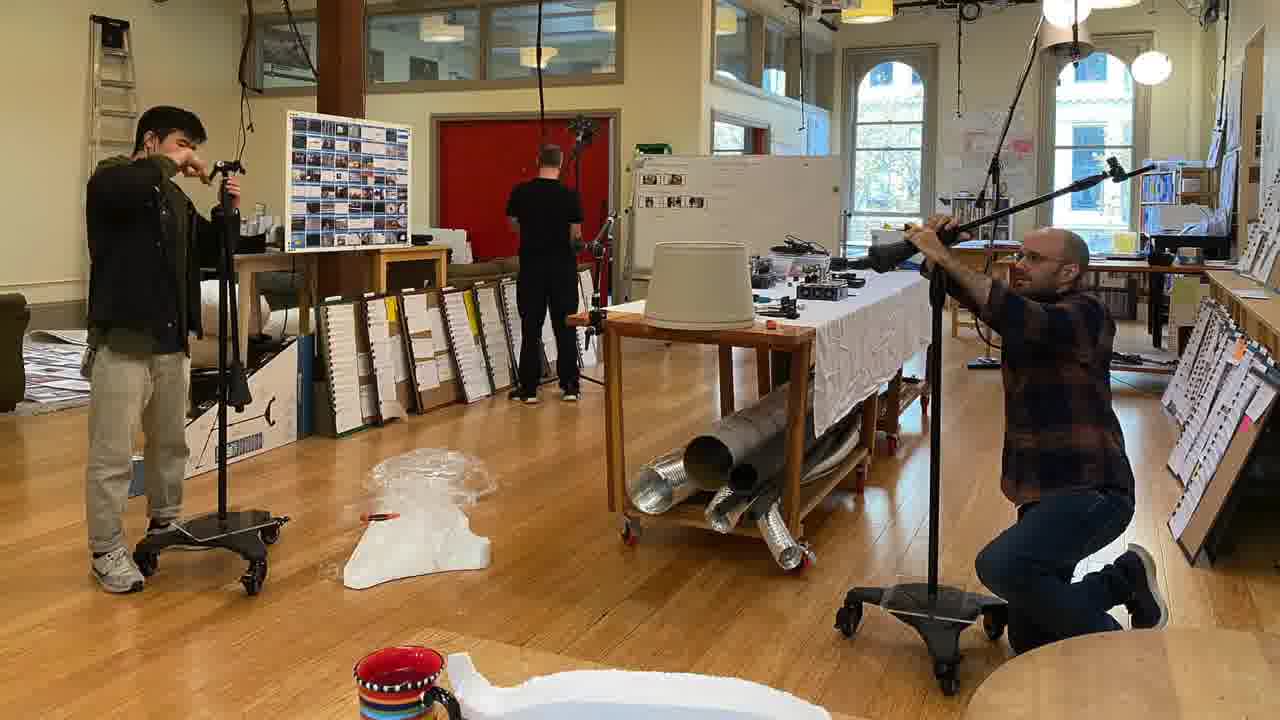
These are the bioscientists that want to start using communal computing. We brought them to a workshop where the first thing that they had to do is they had to build the computer themselves, from scratch. [more]
In this case, they’re putting together the lampposts that are going to hold the projectors. They build their hardware, and they have to build their own software tools.

They borrow our software tools in order to make their own software tools, and then after that, they can use their own tools.
Just an example of how we don’t want this to be something that you download and use, but something that is learned and taught, and every community can make it for themselves.
So, as we think about integrating computation into the built environment, we can ask, is there a form of computation which represents local values, local skills, is developed and maintained locally? Or are you just downloading an app from Google?
Centrally-planned
The second set of values I’m going to put up is pretty closely related to that. That’s this tension between central planning and participatory design. Top-down versus bottom-up.

This is Robert Moses, who was known as the “master builder” of New York. He took a high-modernist Haussmann-like approach in the early 1900s, essentially remaking the entire city. Putting freeways here, and bridges here, and parks here, and demolishing housing there.
At the time, he was kind of seen as a hero. Nowadays, he’s mostly looked back on as a villain.
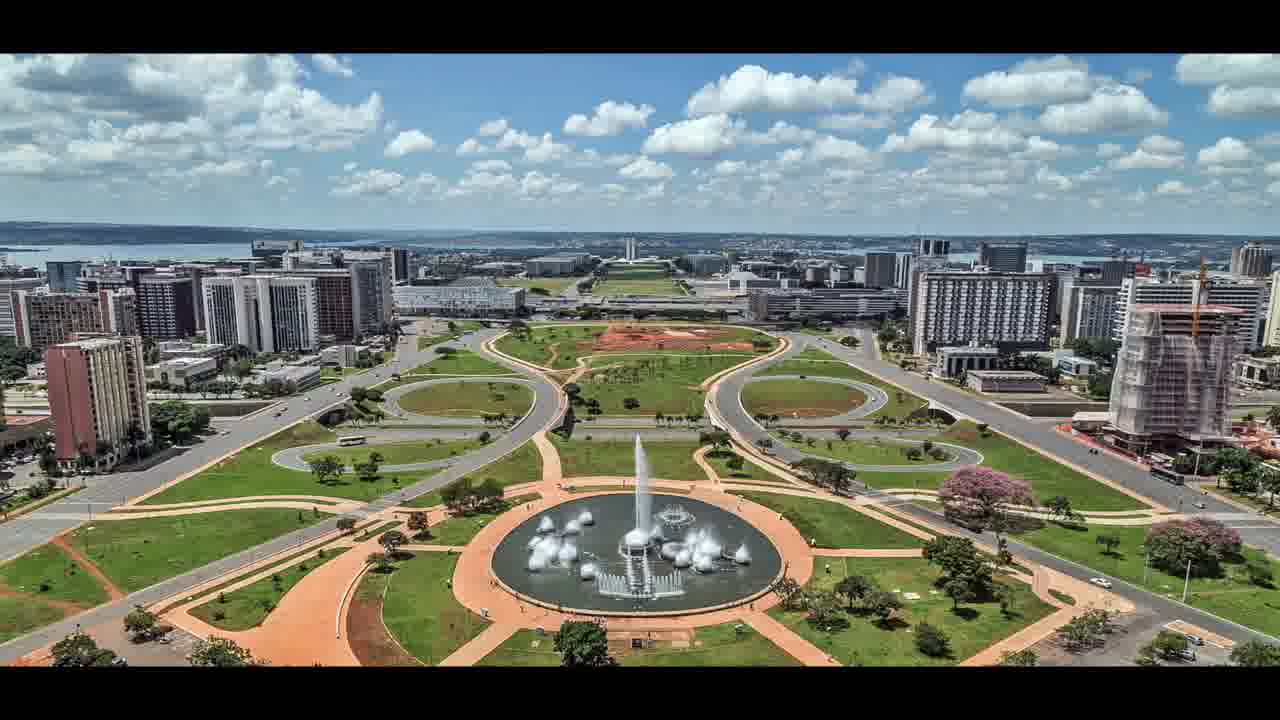
Here’s Brasilia, which is maybe the symbol of a centrally-planned city which looks great from the airplane, and maybe doesn’t work so well for people on the ground.
Again, in the urban design discourse, we have the concept of central planning. We can discuss that. We can debate that. That’s a known concept.
What’s maybe less recognized is that most people spend their entire day in a different kind of centrally-planned environment, which looks like this.

There’s no bottom-up participatory design or democratic governance in Google Docs. That is designed by a committee at a tech company, and you accept it as it is, and you live in that world.

If you don’t like that city, maybe you move to a different city, but it’s exactly the same. It’s all the same stuff.
At least in the built environment, we have a concept of democracy.
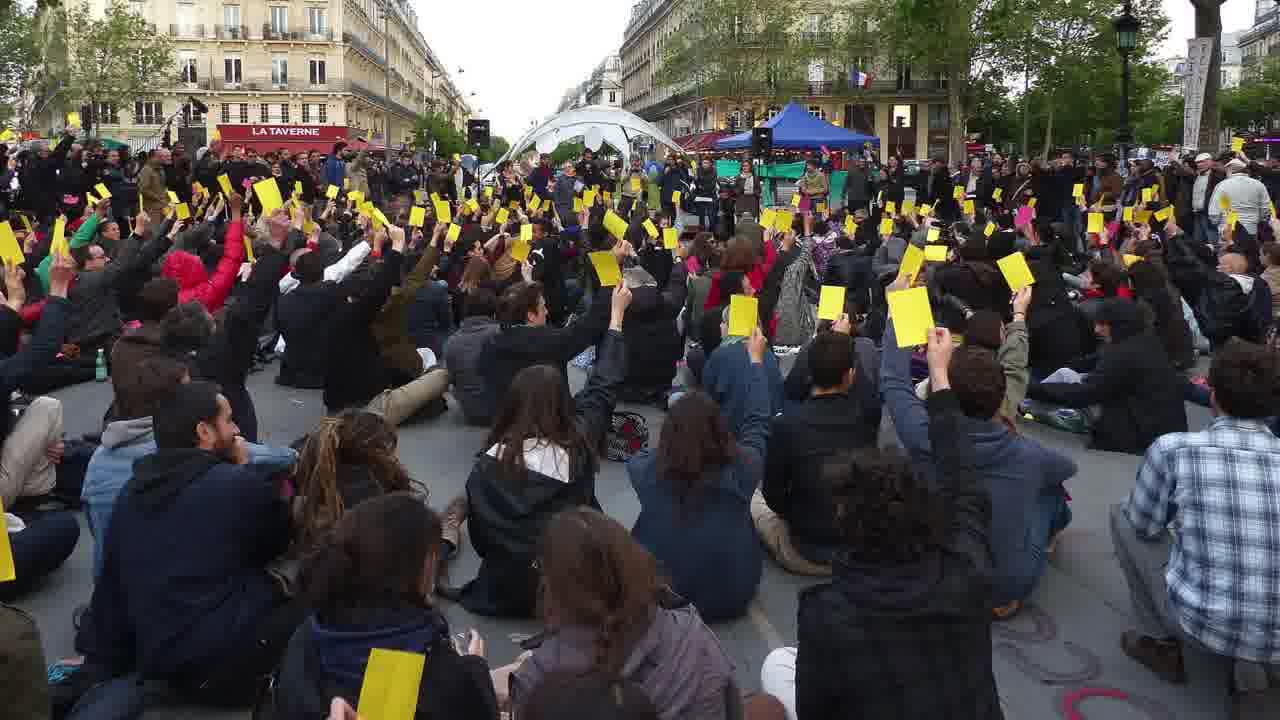
Of democratic design, of democratic governance.
We have a concept of participatory planning, participatory design.
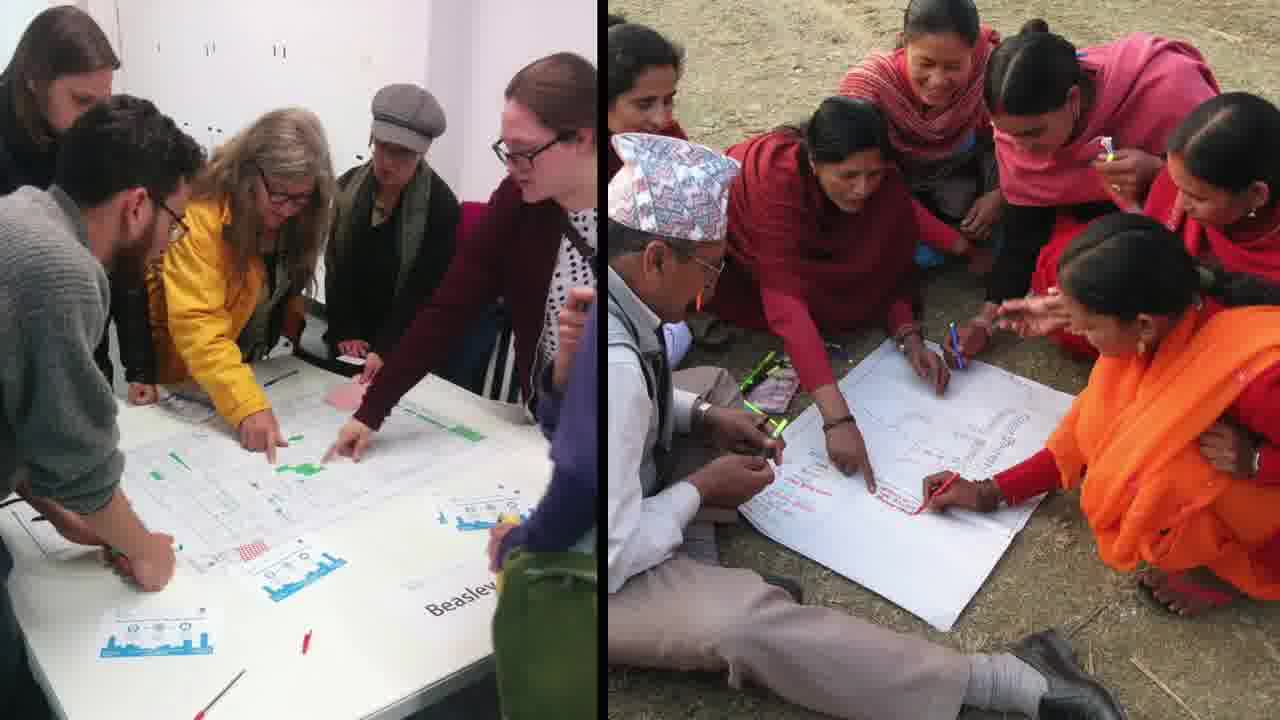
As you’ve seen, most of the activities in the computing system that we’ve made look a lot like these pictures. People gathered around the same space, working on something together.
We’re interested in how computing can support bottom-up participatory practices within a city, within the built environment.
One way that might be is by using computation…
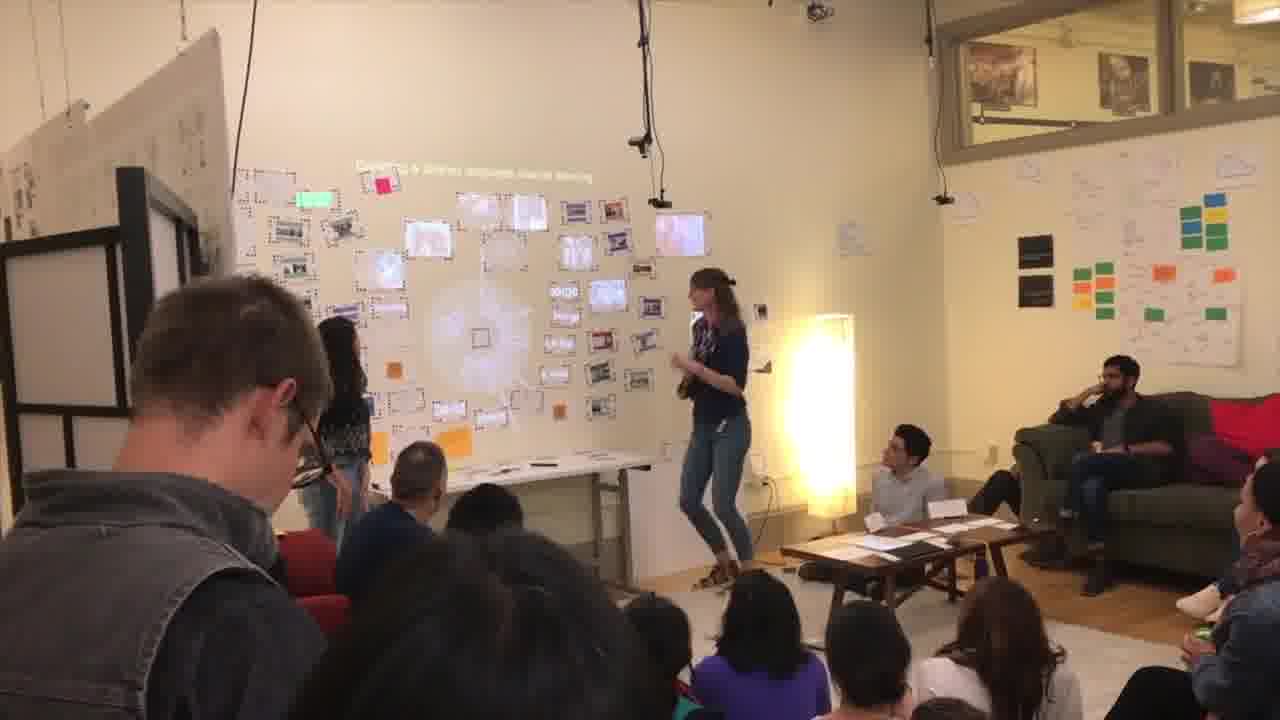
to support communities coming together to discuss and debate issues that are of importance to that community.
Isolating
The next set of values is isolating versus communal.
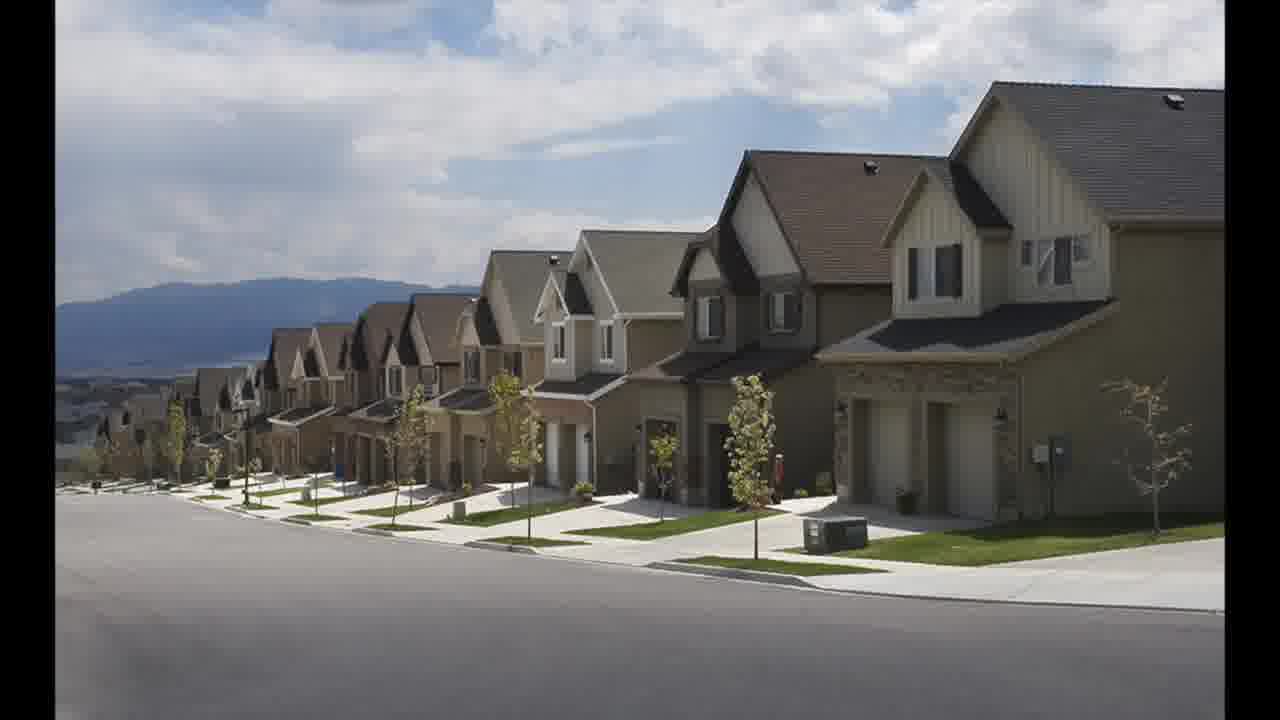
Here are some houses. They’re on the same block. But it’s likely that the people who live in these houses don’t know their neighbors. Because all life either takes place inside the house, or they get in the car and they go somewhere else.
There’s an exactly analogous picture to this in computation.
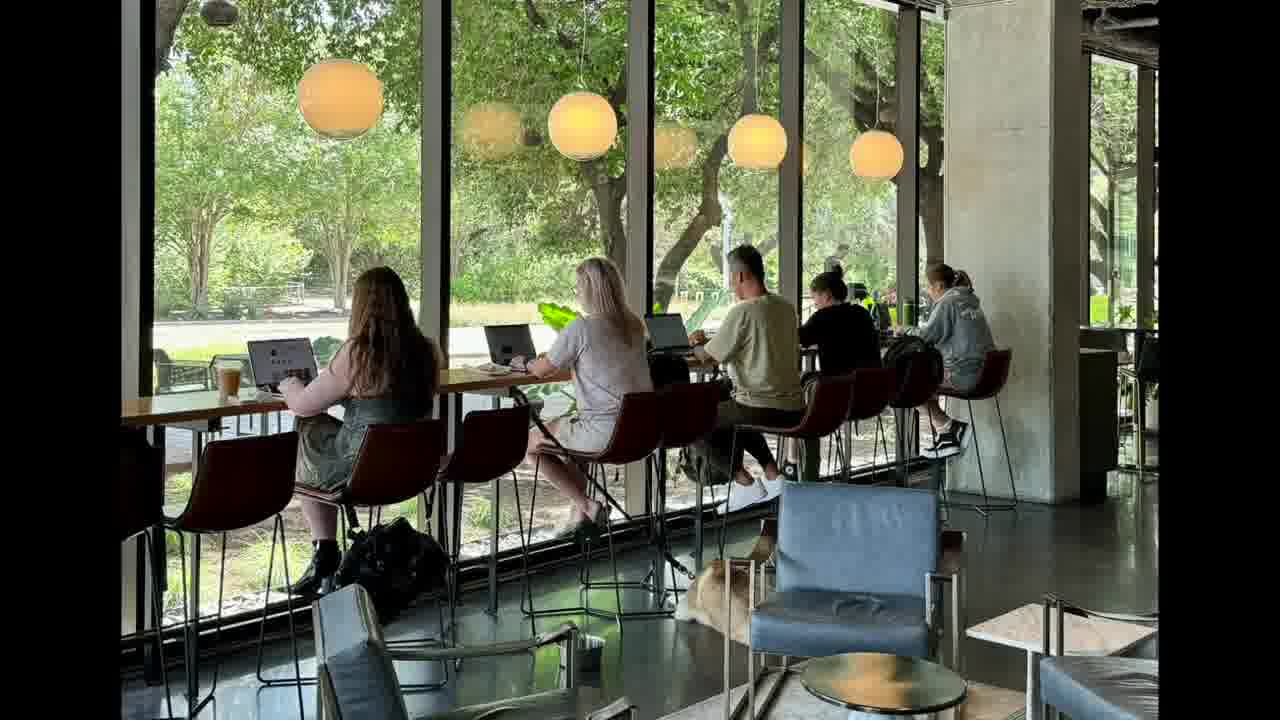
These people don’t know their neighbors. They’re each in their own separate world. They’re not engaging with the people around them.
The people here, and the people here, might be very social people, but the technology is structured in such a way that it’s inherently isolating, that it inherently pulls them apart.
We can contrast that with an environment such as this.
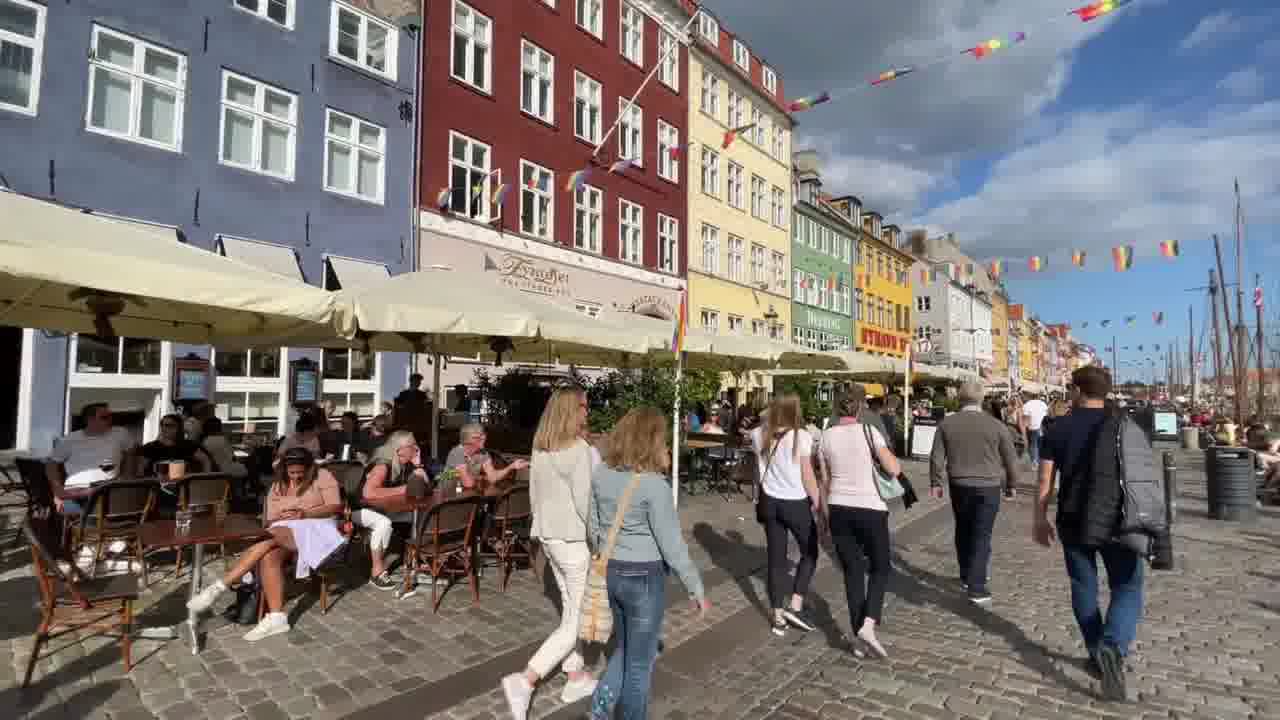
This is Nyhavn (New Haven) in Copenhagen. This is a different approach to housing. Here, the environment is built so that people are always coming in contact with each other.
People are together, they’re always seeing each other, they’re naturally being brought into the same place where they can interact.
That’s exactly the same ethos that we’ve been designing our computational system around.
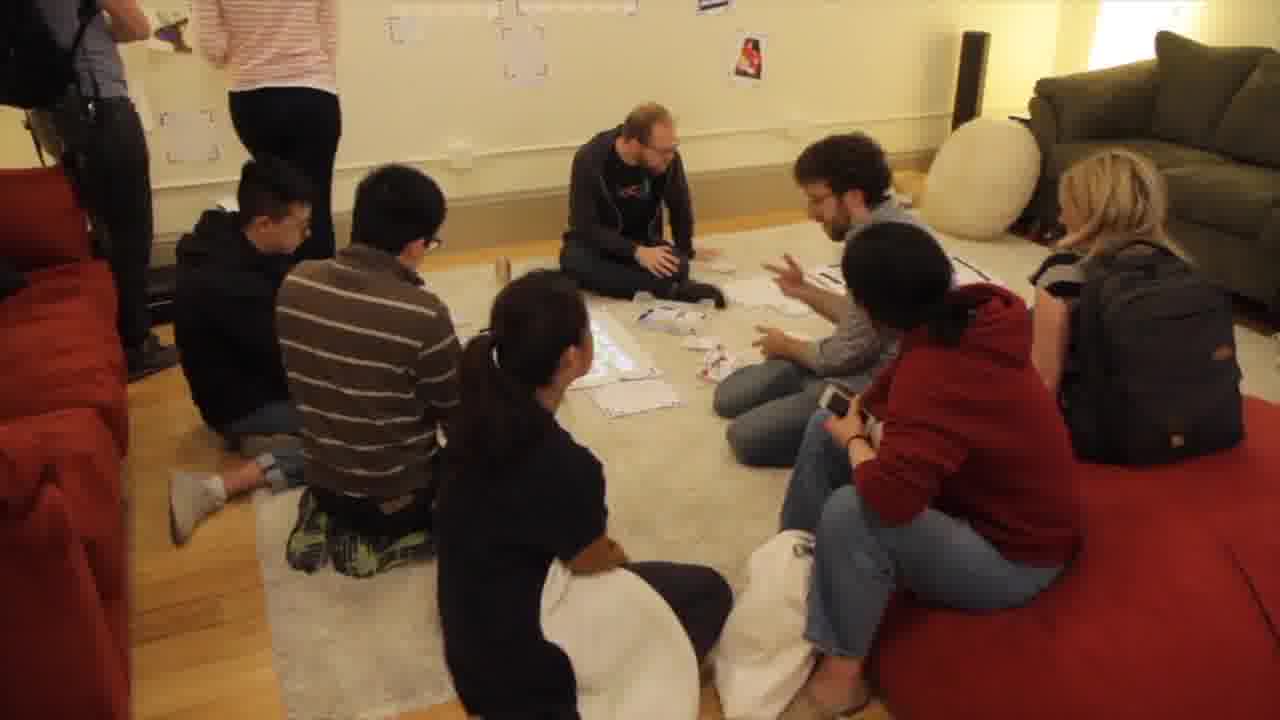
A form of computation where people are naturally brought together and working together in the same space.
You don’t have to be social. If you want to work by yourself, you can just go off in a corner and work by yourself.
But the technology is structured such that it naturally brings people together rather than naturally isolating them.
So, as we think about integrating computation into public spaces… The purpose of public space is to bring people together. You don’t want to pair that with a form of computation that pulls people apart. You want the computation to inherently support people coming together in the space.
Private property
The next value is private property versus public space.
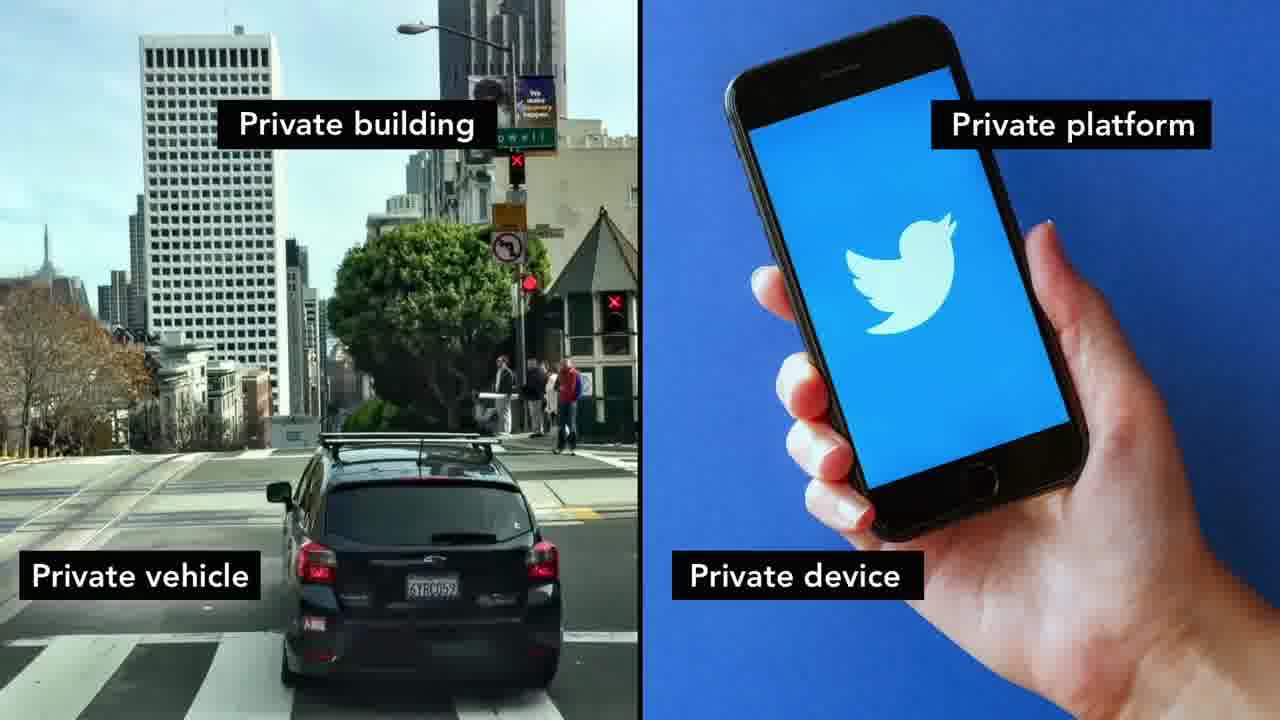
On the left, you spend your day in a privately-owned office building, which you get to in your privately-owned vehicle. On the right, you spend your day on this privately-owned computing platform, which you get to on your privately-owned device.
What’s funny is in both these cases, the roads are public. The streets are public, and the Internet is public infrastructure. But you don’t spend any time on the street. You spend all of your time on private property.
Twitter might feel like a public square, but it’s privately owned. And you find that out when the owner starts asserting his ownership.
At least in the built environment, we have a concept of public property. This is Oakland, California, near where I live.

The yellow regions here are public. The yellow regions are owned by the city.
You can see it’s mostly private property. But the yellow parts are all of the parks, all of the libraries, all of the schools. There’s a bunch of public housing here.
And of course, the squares and plazas are all public spaces that belong to the people.

I think it’s a really interesting question: what is computational public space?
We believe that, in order to have computational public space, you need computation in space. As long as all the computation is within a private device, you’ll never get there.
Like I said, we were operating our community space trying to move in the direction of a kind of public library, public discussion forum, where people from the local community would come together to discuss things that matter to the community.

But that’s just one building. If you want to think about integrating computation into all public space, what does that mean?
We think that it should be a public form of computation. You shouldn’t be downloading a private app from a private vendor and installing that in public space.
So, how can we make public space with computation that actually belongs to the public?
Surveillance
This next value is surveillance versus privacy.
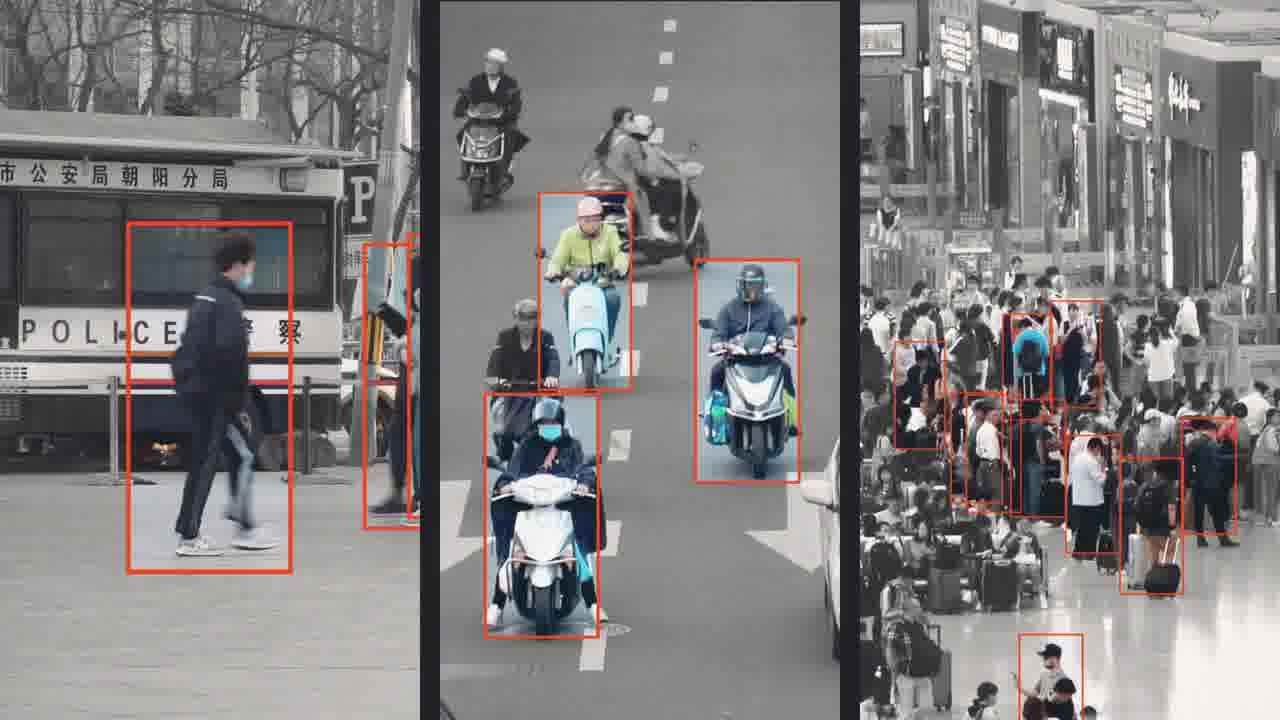
This is a city in China. Given the level of surveillance in the city, I think many of us would be a little uncomfortable with that, or at least would want to discuss and debate the tradeoffs.
But the thing is, the amount of surveillance you’re getting here in the urban environment is actually nothing compared to how much you’re getting in the computational environment.

Everything you do online is recorded and tracked and sold back to advertisers, and that’s Google’s entire business model.
As a counter to that, we get things like legislation, to try to protect people against these privacy violations.

We believe that legislation against privacy is a lost cause. Once you’re working within screens, you’ve already lost the privacy game.
Because in order to do anything within the virtual environment of the screen, you essentially have to turn all of your actions into data.
If all your life takes place within the screen, then you’ve already committed everything about yourself into that virtual space. It’s data, it’s inside your laptop, it can leak out.
I’m sure all of you have laptop computers, and that laptop knows everything about you. It knows everyone you know, it knows all of your conversations, it has all of your personal data.
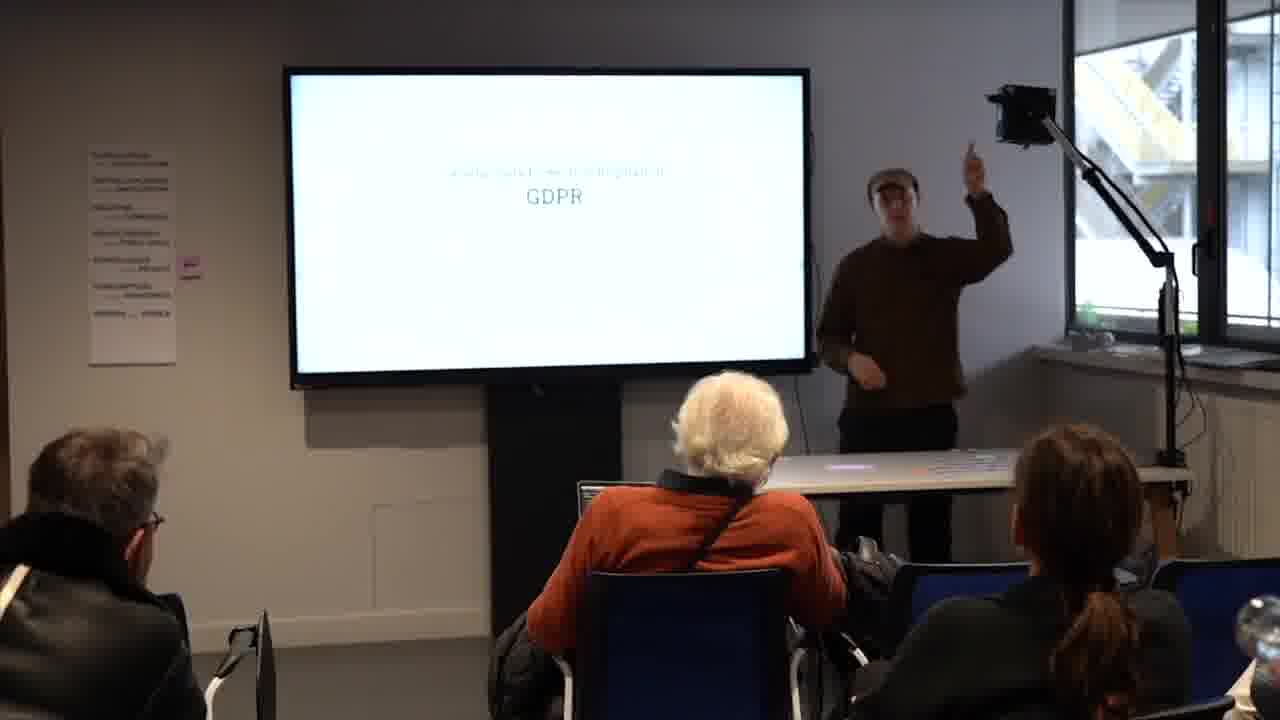
The computer that I’m using to give this talk right now doesn’t even know my name. It knows nothing other than what it sees on the table right now.
Because it’s a form of computation that’s for people coming together in the real world. If you have a conversation in real space, it doesn’t have to go into the computer.
Most of what we do, we’re able to turn into forms of manipulating physical objects in the real world. That doesn’t get into the computer.
And then, for things that do have to be captured within the computational space, they’re all attached to physical objects. And we know how to navigate privacy and security with physical objects.
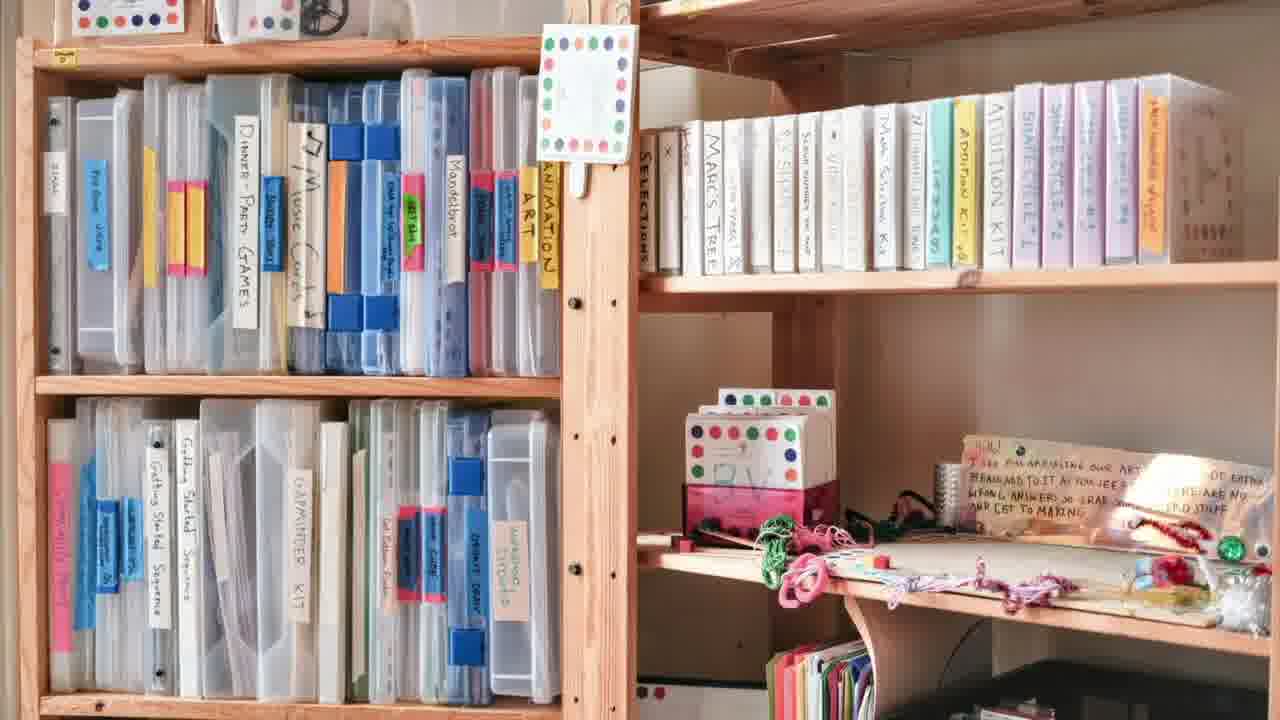
At our space, when people make something that they want to be public, they put it out on a shelf. Or they put it out on a table.
If you make something that you want to be private, you put it in your backpack. No one’s going to go through your backpack. Or if you’re super-paranoid, you go off into a locked room, or something like that.
We know how to work with privacy and security when it’s real people in a real space. If someone’s being really annoying, you can just kick them out of the space, right? We have social norms around that.
Privacy and security become so much easier when you don’t collect any of that data in the first place, and you just work with the social norms.
So, as we think about integrating computation into public space, that’s immediately a huge privacy concern. We want to think about, is there a form of computation that minimizes how much digital information exists.
And I’ll just say that most current forms of AI are about maximizing the amount of information that you collect. This form of computation is about minimizing the amount of information that you collect. That has pretty severe privacy implications.
Consumption
These five up here are pretty well understood, or pretty commonly discussed, issues in urban design. We know what each of these are. We know that there are debates about these.

These last two are a little funny. These last two are something that aren’t really talked about commonly. But we feel that they’re the most promising opportunities for integrating computation into public space.
This first one, I’m calling consumption versus awareness. Yesterday, I was calling it consumption versus depth.
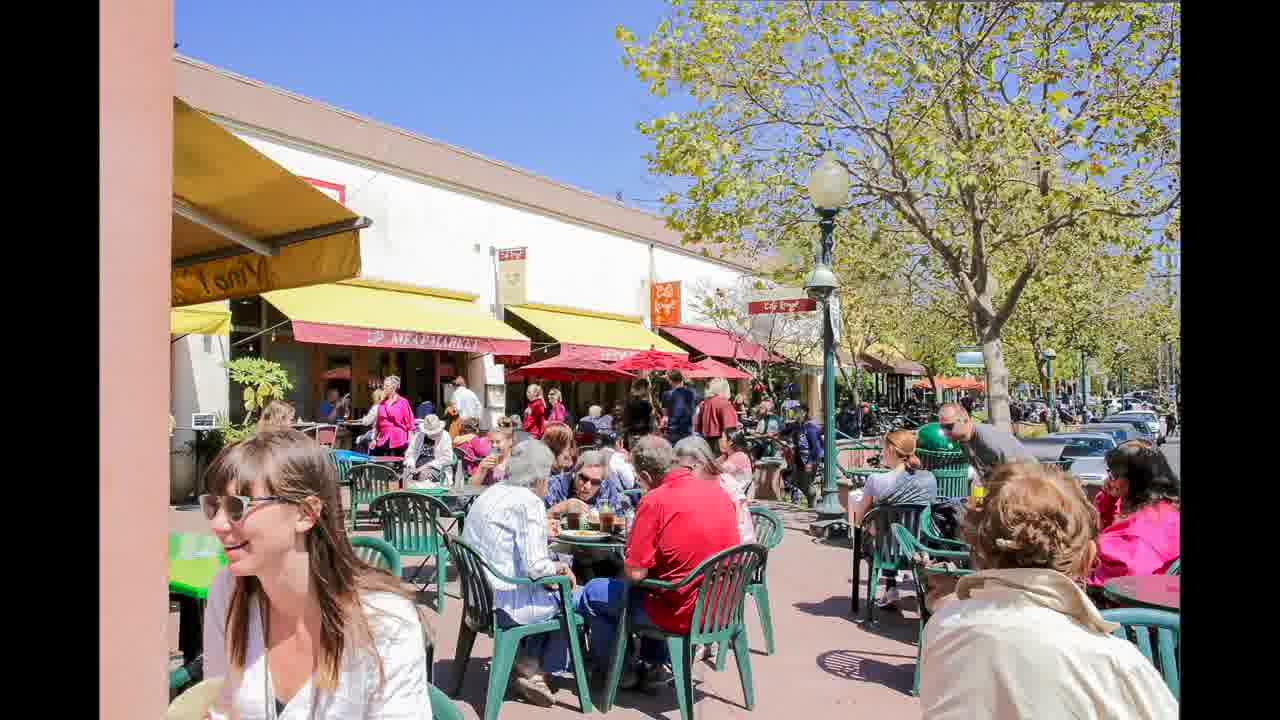
The idea is, when you go into the city, what does the city want you to do?
You go into the city, there’s shops, there’s restaurants, there’s parks, there’s theaters. You shop, you eat, you talk, you entertain yourself.

You pull out your pocket computer and you shop and you talk. And there’s not necessarily anything wrong with shopping and talking and eating. But is that really all we want for ourselves as members of a civilization?
Why are we here? Why do we inhabit a city? Can there be activities that are actually about making us deeper people, about learning and understanding and be able to contribute back to civic life?
And so we have institutions for those, such as libraries and museums.
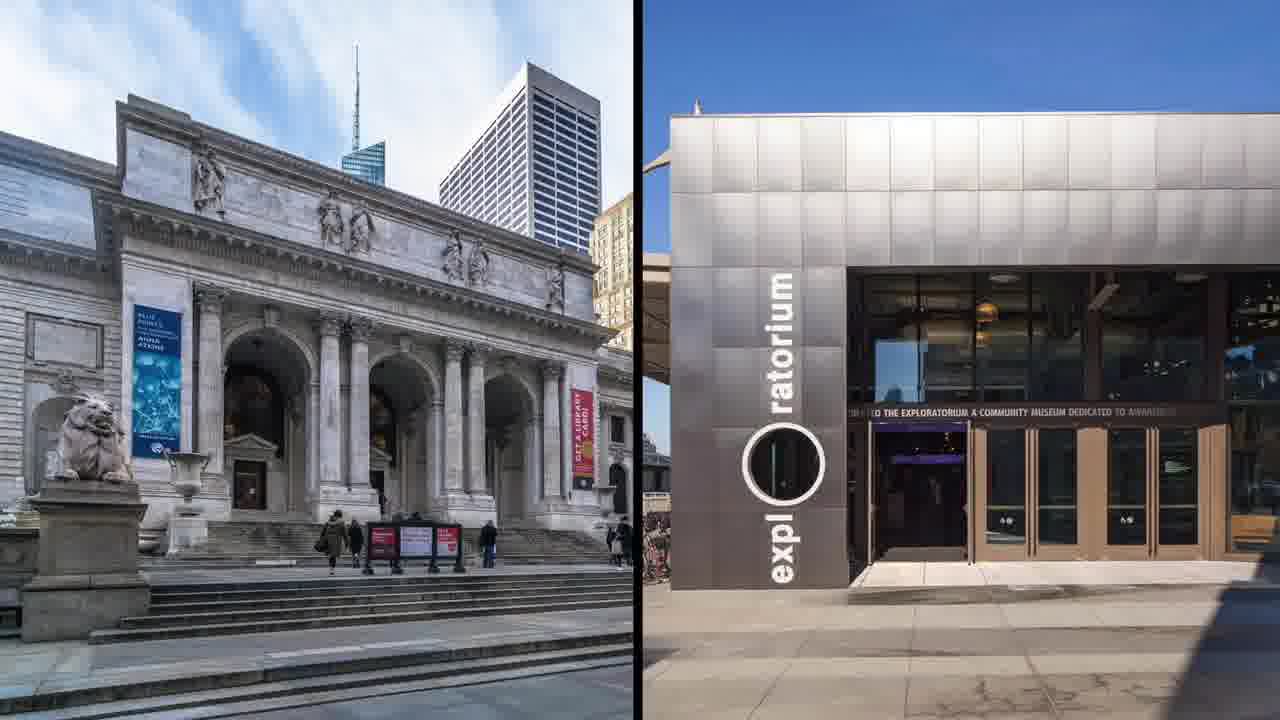
This is the New York Public Library. And this is the Exploratorium, a wonderful science museum in San Francisco.
The problem with these institutions is that they’re isolated from daily life. You go into the library, you go into the museum, you study something for a few hours. Then you come back out, and you shop and you talk.
That’s not how people learn. People learn best by immersion. If you want to learn a language, you go to the country that speaks that language. You use it for everything, you rub up against it every day, it’s part of your surroundings. You don’t learn a language by studying it for a few hours, every once in a while.
And so, integrating computation into public space, we think there’s this amazing opportunity to take the knowledge that’s locked up inside these institutions, and bring it out into public space, into the city, where it can be part of daily life.
Hidden
There’s a few different ways of thinking about that, but the way that I tend to think about it is hidden versus visible.
There are many ways in which a city is a black box.
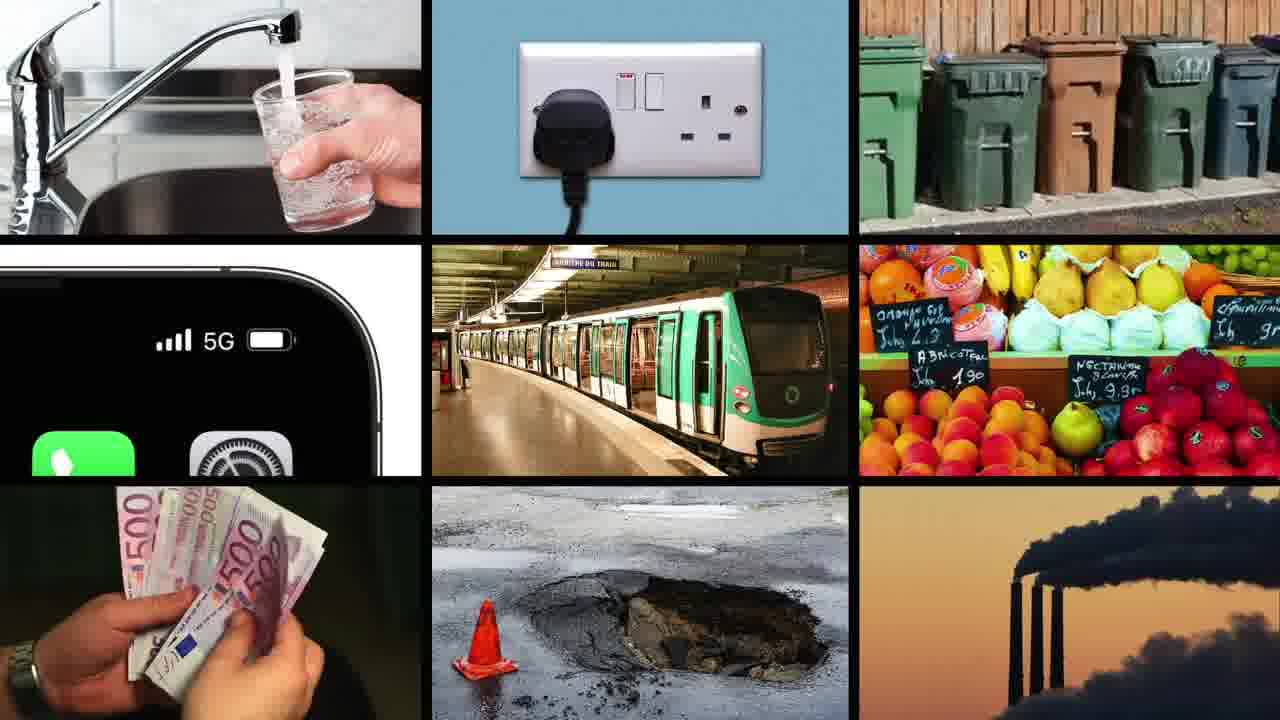
If you’re thirsty, you pull this lever here, water comes out, you’re satisfied, but you don’t get any sense of where that water came from.
I think most of us have a very vague understanding of: there must be pipes, and a reservoir, a filtration system… We don’t see any of that. We just see the endpoint of this much larger system, which is hidden.

You put a plug into the wall and electricity comes out. What is electricity? Where is it coming from? How is it generated? It matters a lot now how electricity is generated.
We don’t see any of that. That’s not part of our daily experience. We’re only experiencing the endpoint.
But as a democratic society, where we want to collectively govern ourselves, we have to understand the systems that we’re immersed in. We haven’t done a good job of making those systems visible.
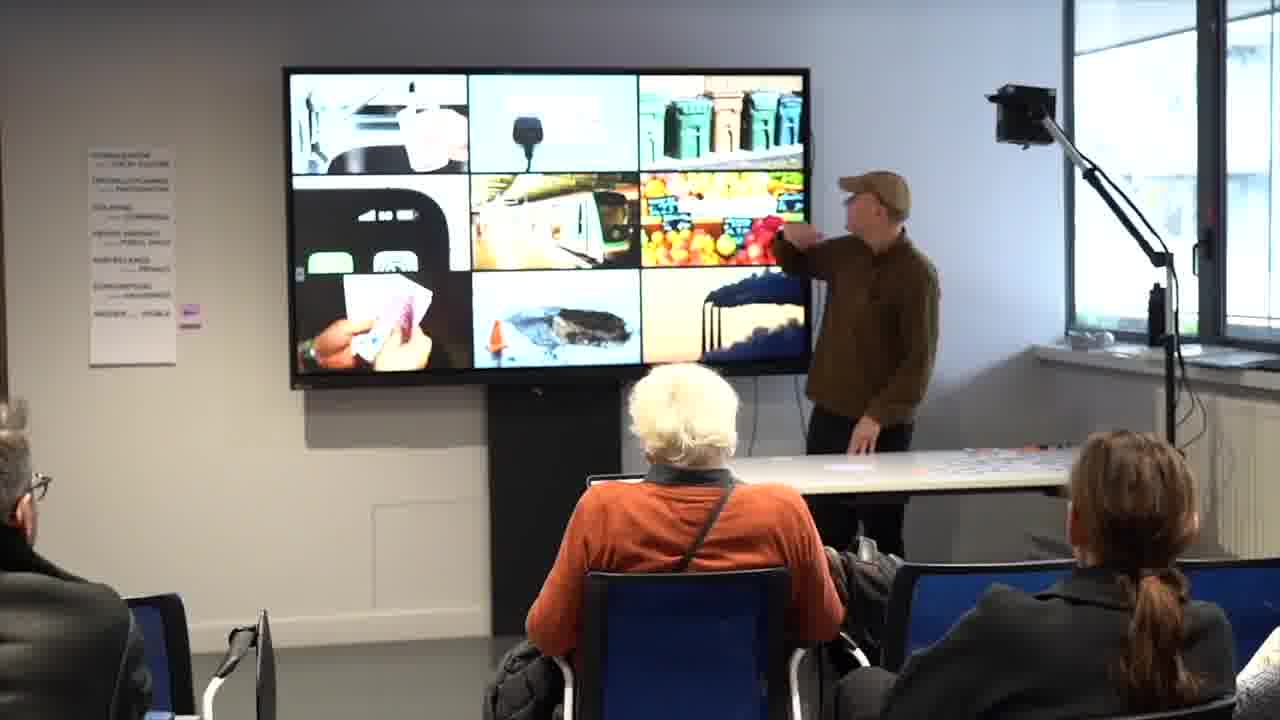
You put something in a bin and goes away. Where is “away”?
Every time you do this, you’re having an action elsewhere. How can we have a sane democratic society if we don’t understand the effects of our actions?
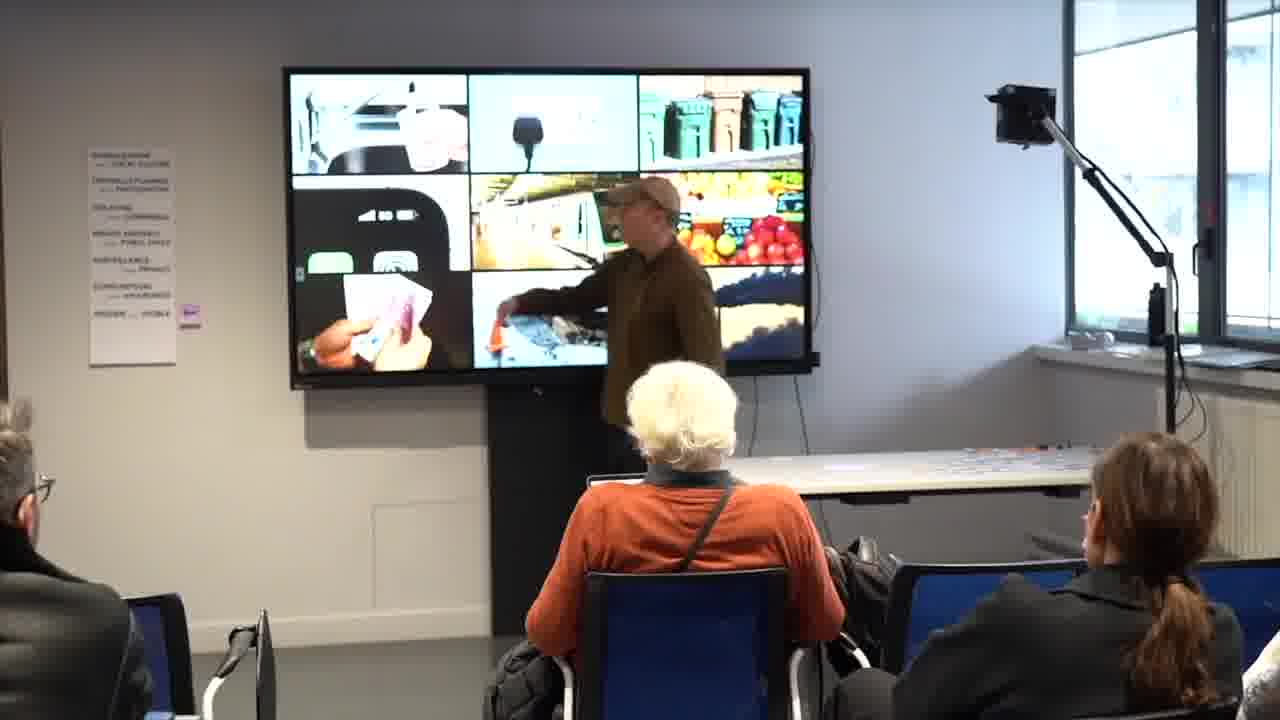
We pull internet through the air. I think most of us don’t really get: What is the internet? How can it travel through the air? How does the phone work?
We depend on this for everything. For most people, this is magic. And you can’t build a civilized society on magic and superstition. It has to be grounded in understanding of the systems we’re part of.
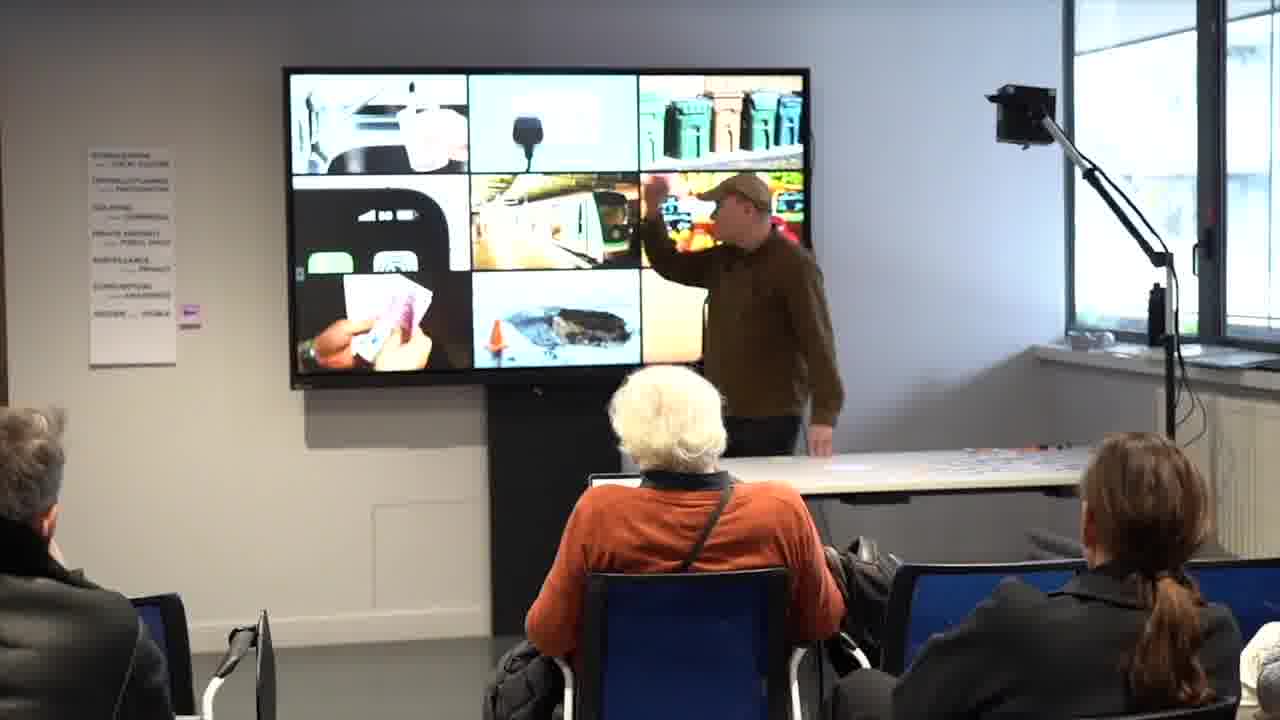
How transit systems work. I think this is actually a really interesting starting point, because we’ve already built the spaces. Subway stations, as spaces, already exist. And right now they’re just devoted to sitting around and waiting and eating from the vending machine.
But those spaces could essentially be immersive information spaces for actually understanding the transit system, and understanding the effects of it.

When you buy something, you are part of a global supply chain. Basically, every person on earth is part of a global economy, which you’re plugging into every time you buy something. And you can’t see any of that.
You cannot see the global supply chain, you cannot see the effects that you’re having. You only see this endpoint. But we think computation in the built environment could actually provide a view into this much deeper thing.
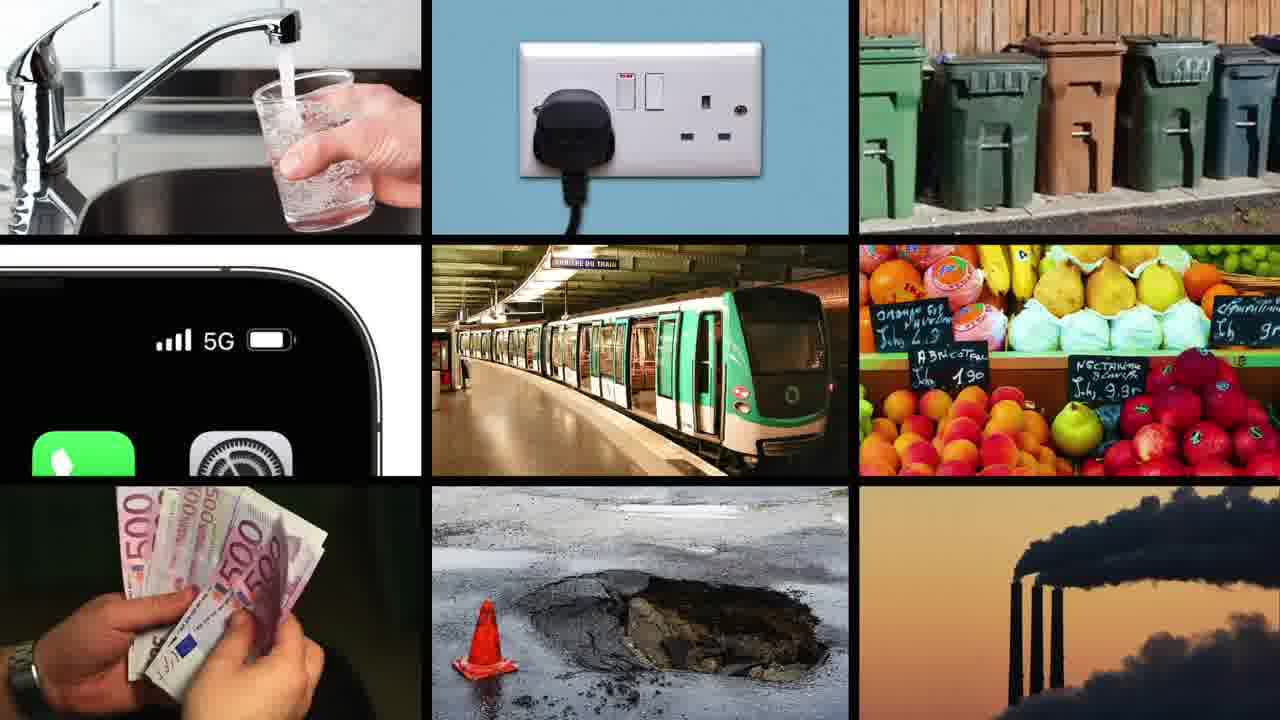
You pay taxes. Where do those taxes go? What are they used for?
Again, you can look this stuff up, you can go into the library or go online, but that doesn’t stick with you. You read about something, but then you go out into the world, and it’s not actually reflected in your daily experience in the world.
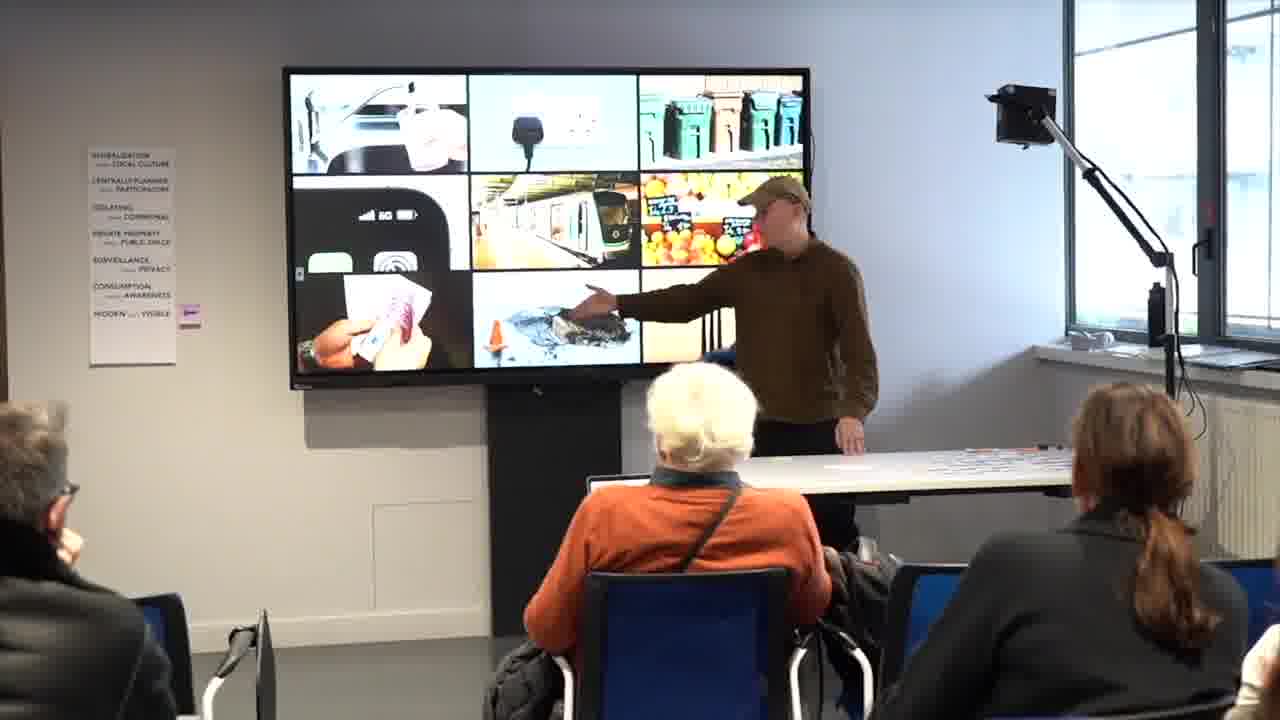
Quality of service throughout a city.
Are there different parts of the city that get different quality of service? Are there different parts of the city that are wealthier? Are those correlated? Maybe we care about that?
This is something that we can understand anecdotally, but we can’t understand systemically, because it’s not something we experience as a whole system.
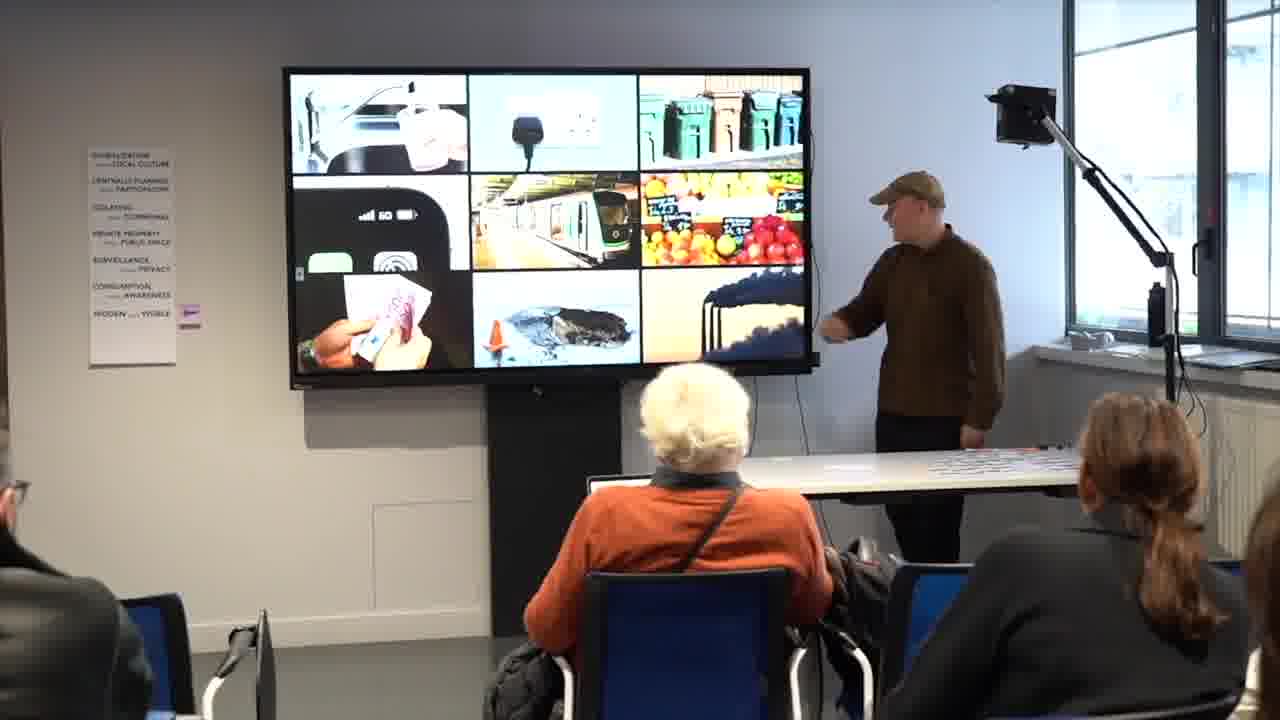
Finally, of course, every action we take is releasing greenhouse gases which are having a literally catastrophic effect, and you can’t see any of that.
So we think there’s this, again, enormous opportunity to use computation in public space to start to get to the visibility of these systems. Perhaps even starting with the touchpoints that we have with them.
When you pull the lever to get water, maybe that’s your entryway to start understanding the water system. When you plug in to your electricity, that’s your entry point to start understanding the electrical grid.
I already talked about subways. That’s a very low-hanging fruit for that.
I don’t know exactly what that’s going to look like. I think it’s going to require integrating powerful interactive visualizations and computation into public space.
Our brains haven’t changed in a hundred thousand years, but we’ve built this very complex society around ourselves, and we’ve decided that we want to collectively govern it. We can’t do that if we can’t see or understand how any of this works.
Summary
To summarize, as we’re thinking about integrating computation into public space, there’s a number of really interesting questions here.
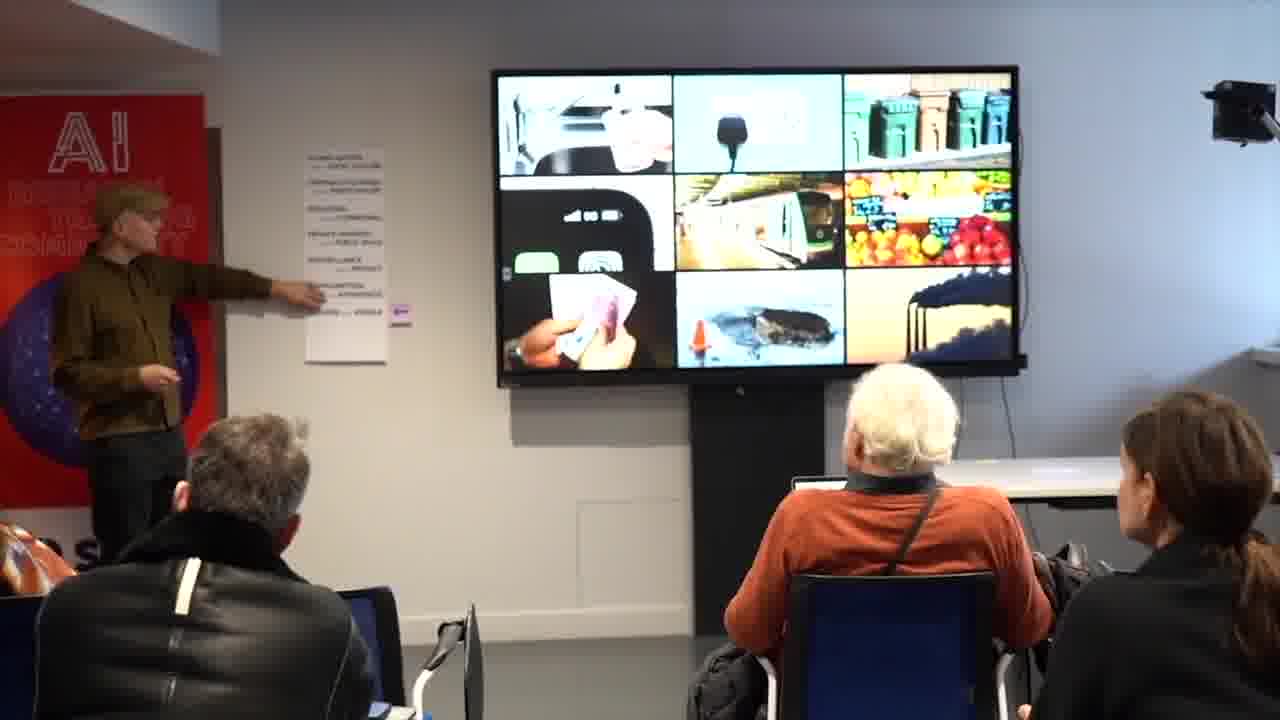
One is: can it be a locally-grown computational system? Does it have to continue to propagate the idea of mass-market products, and tech companies determining whatever it does? Or can we have a form of computation which is built and maintained and understood by people in the local community?
How can computation in public spaces support participatory, bottom-up, collective decision-making?
If we want public spaces to bring people together, can we have a form of computation which is also about bringing people together, and not about isolating people?
What is computational public space? Is it appropriate to use private products from private vendors to support a public space?
How do we integrate computation into public spaces without enormous privacy violations? Can we use a form of computation that just doesn’t care about any data in the first place?
Can computation in public space be used to give us insight and awareness to these vast invisible systems that we live in and are responsible for?
And, can we do that by making these invisible systems visible, allowing us to be able to see them and grapple with them and discuss them as we go about our daily lives?
Thank you.
